

This report is the third in which the UEFA Intelligence Centre has showcased European club football competitions specifically and the successes and challenges of the talent competing within them.

It goes beyond the headlines to provide granularity on subjects such as match attendance, transfer trends, player usage and head coaches.

The UEFA Intelligence Centre landscape reports have long brought transparency to European football in support of evidence-based planning and policymaking. If you love football, why not explore further?
01

Attendance
Attendance growth across European football with all-time record crowds recorded in men’s top-tier competitions, lower-tier competitions and UEFA club competitions during 2024/25.
In a world where more matches are televised and more online content is available than ever before, the appetite for live experiences is stronger than ever.
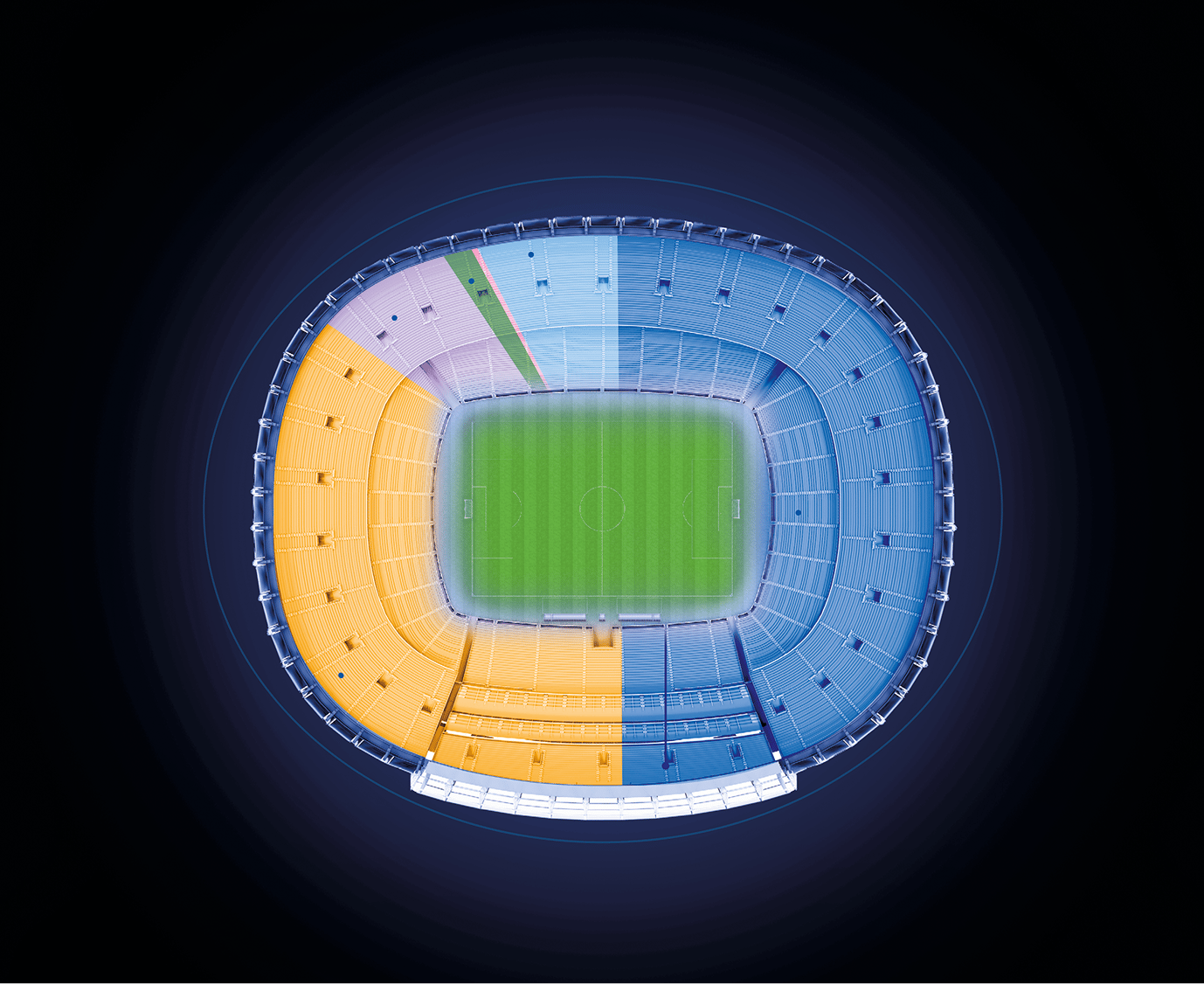
14 million
[+2.8%]
Men’s domestic cup crowds
0.5 million
UEFA Women’s
Champions League crowds
4.0 million
Women’s domestic
club competition crowds
20 million
[+13%]
Men’s UEFA club
competition crowds
81 million
[+0.7%]
Men’s lower-tier professional
league crowds
114 million
[+2.5%]
Men’s top-tier league crowds
Unprecedented attendance levels in European club football
Hover over the plus markers to view spectator figures by competition
Hover and hold the plus markers to view spectator figures by competition






227 million
spectators at European football matches in 2024/25 (club football and national team crowds)
17 leagues
recorded their biggest crowds in at least a decade
35 clubs
enjoyed home attendance of more than 1 million
More than
80 million people
attended lower-league matches beyond the top tier
02

Competitions
European football calendars and formats continue to evolve. UEFA stands alongside all other stakeholders to proudly protect the European sports model and the pyramid structure that connects grassroots football to the elite club game.
Promotion and relegation generate suspense and keep things real at all levels of the European football pyramid

1,220
different clubs
have played in their top-tier league in the last decade

The final UEFA Conference League spot is decided by a post-season
play-off in ten top tiers, adding suspense to the end of the domestic league season

Domestic cups remain a vibrant part of the calendar, with 86 clubs outside the top tier reaching at least the quarter-finals last season

A majority of countries had a change of league champion in 2024/25, with the lowest number of repeat winners since 2010/11

210+

170+

80+

72

140+

130+

110+

78

80+

90+

65+

70

60+

20+

10+

20
Top tier
712 clubs
Second tier
805 clubs
Third tier
1,530+ clubs
Fourth tier
2,880+ clubs
Fifth tier
4,380 + clubs
DIRECT PROMOTION
Qualify for promotion play-offs
DIRECT RELEGATION
Qualify for relegation play-offs
03

TRANSFER
TRENDS
This summer’s transfer window saw further record investment, reflecting confidence in the European club football market on the back of record club revenues.
Average deal prices paid increased in most major transfer markets with the high average transfer fee in the Premier League highlighting the dominance of English clubs.

2. BUNDESLIGA
Average of over 29,000 spectators per match
4th highest average league attendance in world football last season
ENGLISH CHAMPIONSHIP
Average of over 23,000 specattors per match
2nd highest aggregate league attendance in world football last season

2. BUNDESLIGA
Average of over 29,000 spectators per match
4th highest average league attendance in world football last season.
ENGLISH CHAMPIONSHIP
Average of over 23,000 specattors per match
2nd highest aggregate league attendance in world football last season.
European lower-tier matches bring 76 million fans in attendance
Top tier
Third tier
Fourth tier
Fifth tier
Amateur level
Second tier
2. BUNDESLIGA
Average of over 29,000 spectators per match
4th highest average league attendance in world football last season
ENGLISH CHAMPIONSHIP
Average of over 23,000 specattors per match
2nd highest aggregate league attendance in world football last season


Amateur level

Fifth tier

Fourth tier

Third tier

Second tier

Top tier
European lower-tier matches bring 76 million fans in attendance
2. BUNDESLIGA
Average of over 29,000 spectators per match
4th highest average league attendance in world football last season.
ENGLISH CHAMPIONSHIP
Average of over 23,000 specattors per match
2nd highest aggregate league attendance in world football last season.
2. BUNDESLIGA
Average of over 29,000 spectators per match
4th highest average league attendance in world football last season
ENGLISH CHAMPIONSHIP
Average of over 23,000 specattors per match
2nd highest aggregate league attendance in world football last season

Amateur level

Fifth tier

Fourth tier

Third tier

Second tier

Top tier
European lower-tier matches bring 76 million fans in attendance


English Championship
23,000 Average spectators per match
2nd Highest average league attendance in world football last season

2. Bundesliga
29,000
Average spectators per match
4th Highest average league attendance in world football last season

Top tier
Third tier
Fourth tier
Fifth tier
Amateur level
European lower-tier matches bring 72 million fans in attendance
2. BUNDESLIGA
Average of over 29,000 spectators per match
4th highest average league attendance in world football last season
ENGLISH CHAMPIONSHIP
Average of over 23,000 specattors per match
2nd highest aggregate league attendance in world football last season
ENGLISH CHAMPIONSHIP
Average of over 23,000 specattors per match.
2nd highest aggregate league attendance in world football last season.
2. BUNDESLIGA
Average of over 29,000 spectators per match.
4th highest average league attendance in world football last season.
Second tier

European lower-tier matches bring
65 million
fans in attendance

European lower-tier matches bring
74,999,900
fans in attendance
Lorem ipsum dolor sit amet
RECORD EARNINGS
39% increase
From last summers’ transfer earnings, with Saudi Arabian transfer spending helping European clubs earn more than ever before
TREND OF INVESTMENT IN YOUTH
68%
Of all transfers fees invested in players 23 or younger - a decade ago the share was less than 50%
ENG FLOW / LIQUIDITY
€2.7 billion
estimated English club gross transfer spend. Almost exactly the same as the other ‘big5’ countries combined.
KSA FLOW
€800 million
Saudi Arabian club net spend, joining the English clubs in providing a second large source of transfer profits for talent developers. All other major markets were net earners during the summer.

€6.1m
Average price paid by Big 5 clubs for inbound senior players
Average fees increase in most of the major transfer markets (16/20)

€21.5m

€5.5m

€4.8m

€3.6m

€3.7m
Average price of inbound senior players in summer transfer windows (€m), top 20 leagues by spend
25%
Average price increase in top 20 leagues
(compared with summer 2024)
+42%
+35%
+18%
+17%
-22%
+102%
+76%
+146%
+19%
+38%
+24%
+25%
+240%
+45%
-17%
-11%
+304%
+29%
+21%
-35%
Value (€m)
League
Change since summer 2024
22.2
6.2
5.5
4.3
4.2
1.9
1.5
1.4
1.3
1.2
1.0
0.69
0.48
0.43
0.41
0.37
0.25
0.23
0.15
0.14
ENG
GER
ITA
ESP
FRA
TUR
POR
NED
ENG
(2nd tier)
RUS
BEL
DEN
UKR
GRE
SCO
AUT
POL
GER
(2nd tier)
ESP
(2nd tier)
ITA
(2nd tier)
55% of all transfer fees were invested in players aged 23 and under
The prices for full backs and attacking/wide midfielders have increased the most of any position this summer – players selling for 64% more than the price of their previous transfers
04

TALENT
The report compiles data on squad regulation and player usage, which then informs discussions about player workload, match calendars, competition formats and rules, competitive balance and transfer and finance regulations. The report also provides a unique review of the head coach landscape.


Clubs are adapting to workload pressures by spreading match time across more players, using their full subs allocation and rotating their squads.
15.5
Average number of players fielded by each club during their league season
1,456
more players fielded in domestic top-tier leagues than in 2019/20 (before the five subs rule)
7%
of first-team squad players featured in over 30 league matches

700
head coach
changes
less than one change per top-division club for the first time in the last decade
head coaches
The most in-demand head coaches working abroad in top-level football


ESP

ITA

POR
06

COUNTRY KPIs
The report covers much more than just the biggest clubs and leagues. More than 700 clubs are analysed each year, providing a 360-degree snapshot that can be explored below.

Iceland
Denmark
Norway
Sweden
Faroe Islands
Scotland
England
Wales
Republic of Ireland
Northern Ireland
Portugal
Gibraltar
Spain
Andorra
France
Belgium
Luxembourg
Netherlands
Germany
Finland
Russia
Kazakhstan
Azerbaijan
Armenia
Georgia
Turkey
Poland
Cyprus
Israel
Ukraine
Belarus
Lithuania
Latvia
Estonia
Slovakia
Hungary
Bosnia & Herzegovina
Kosovo
North Macedonia
Greece
Albania
Montenegro
Croatia
Slovenia
Austria
Czechia
Switzerland
San Marino
Italy
Malta
Romania
Moldova
Bulgaria
Serbia
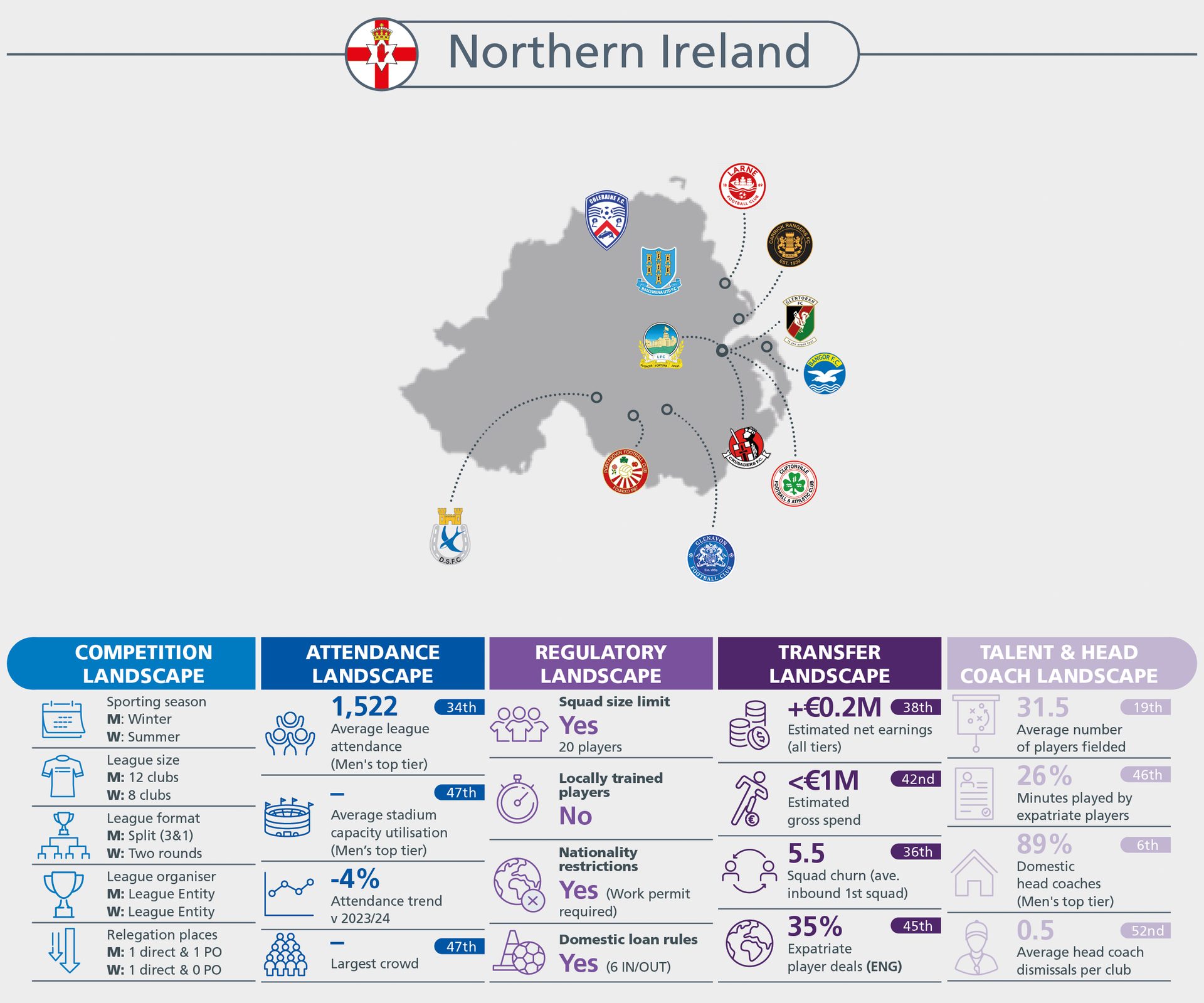
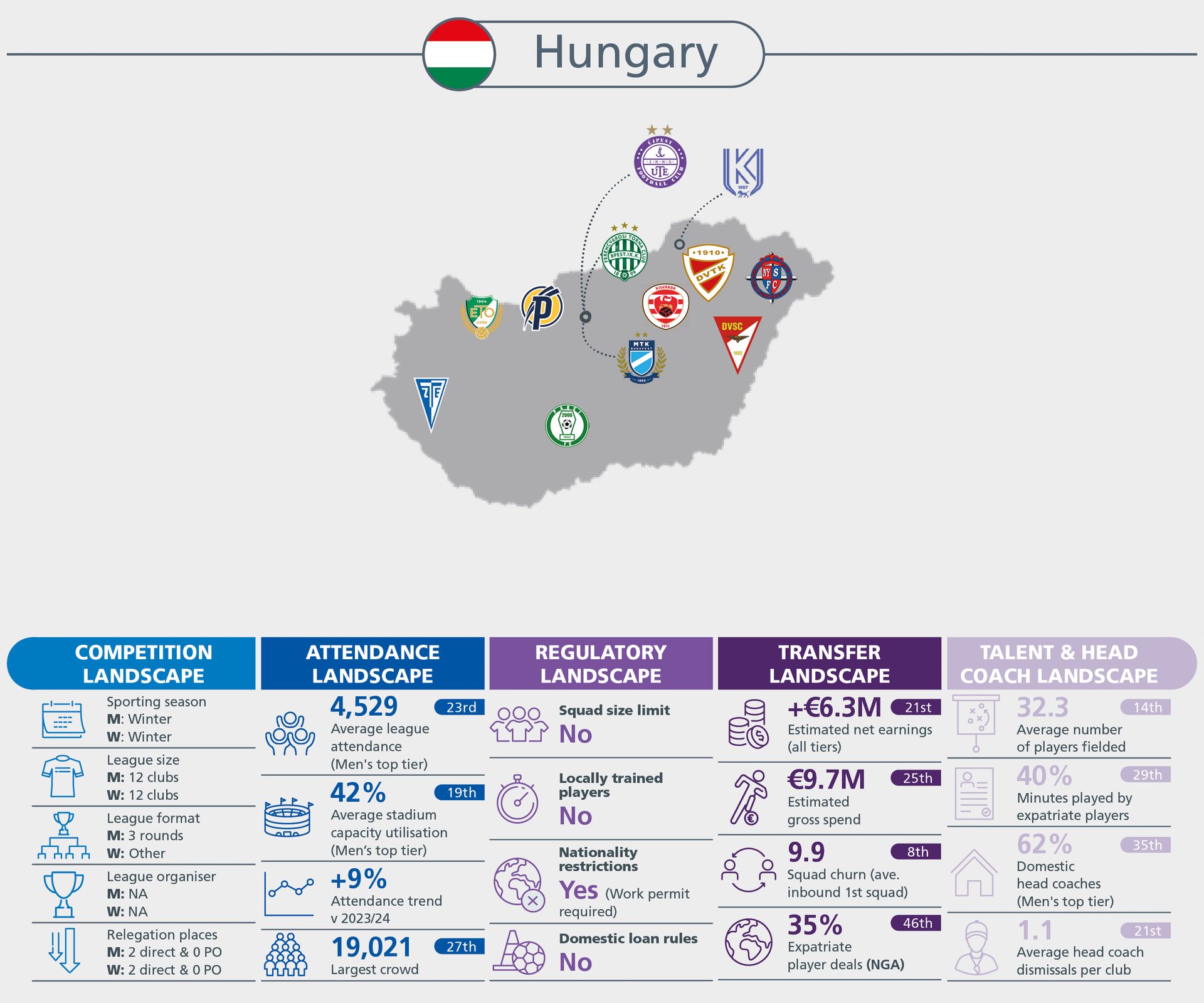
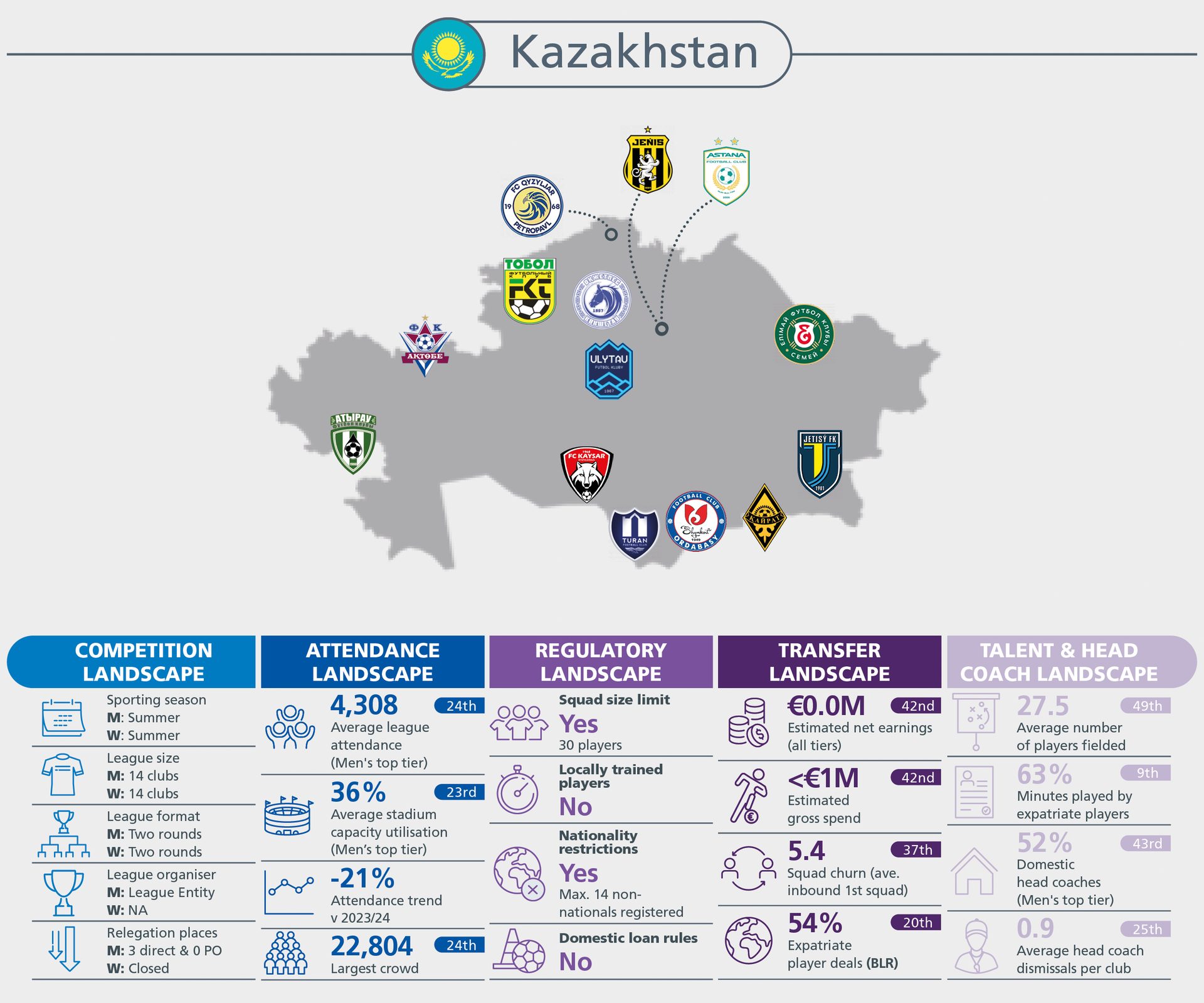
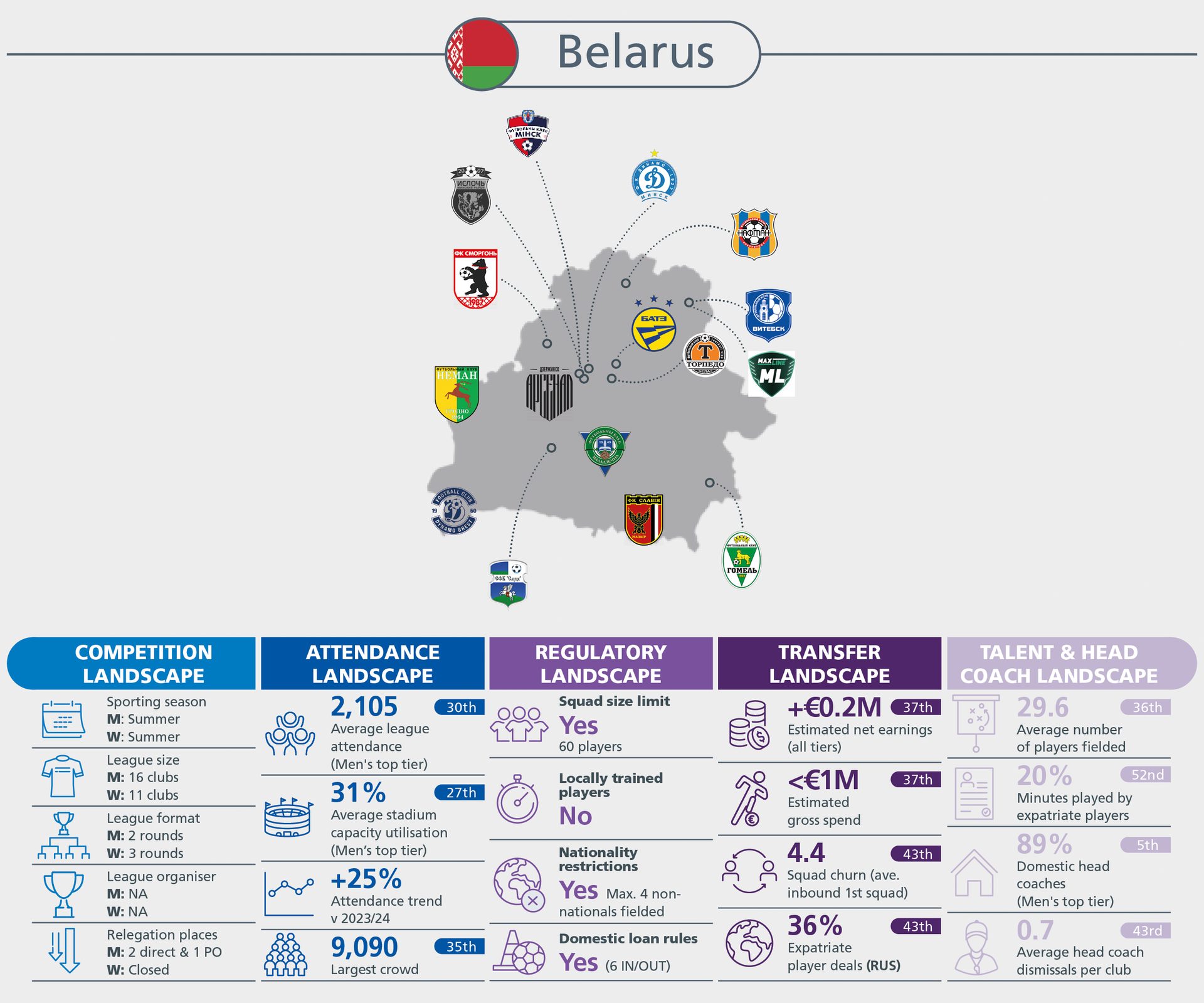
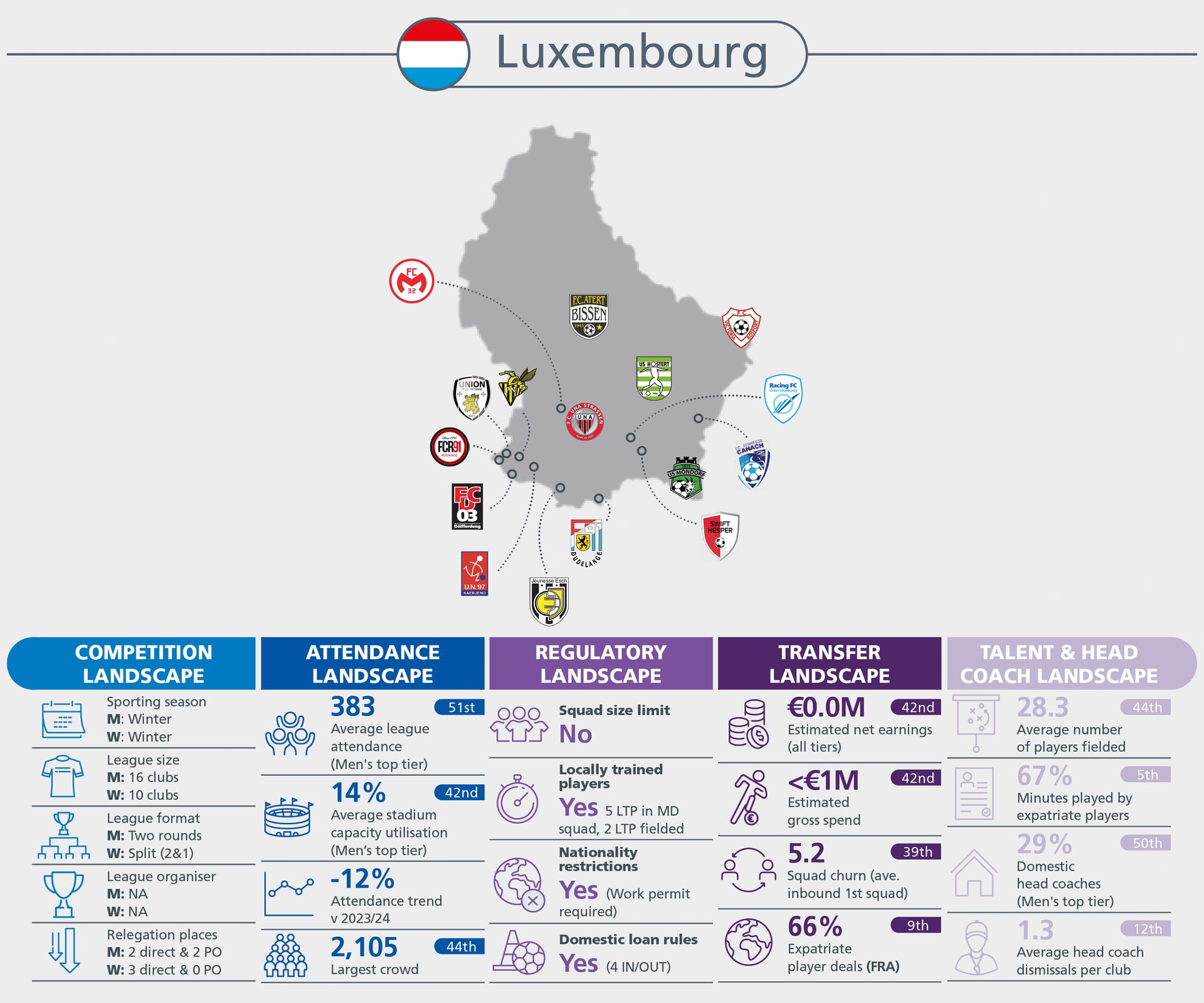
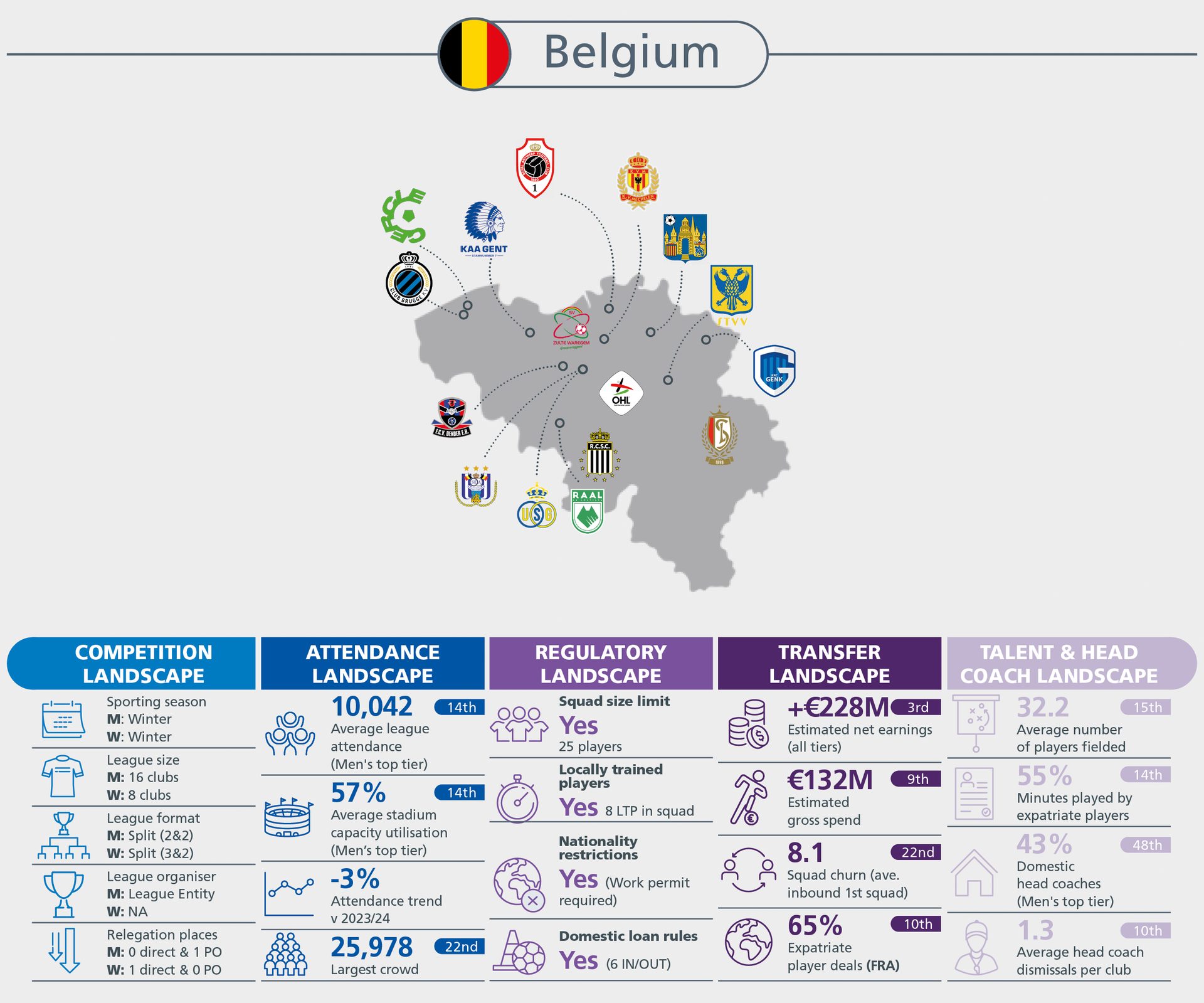
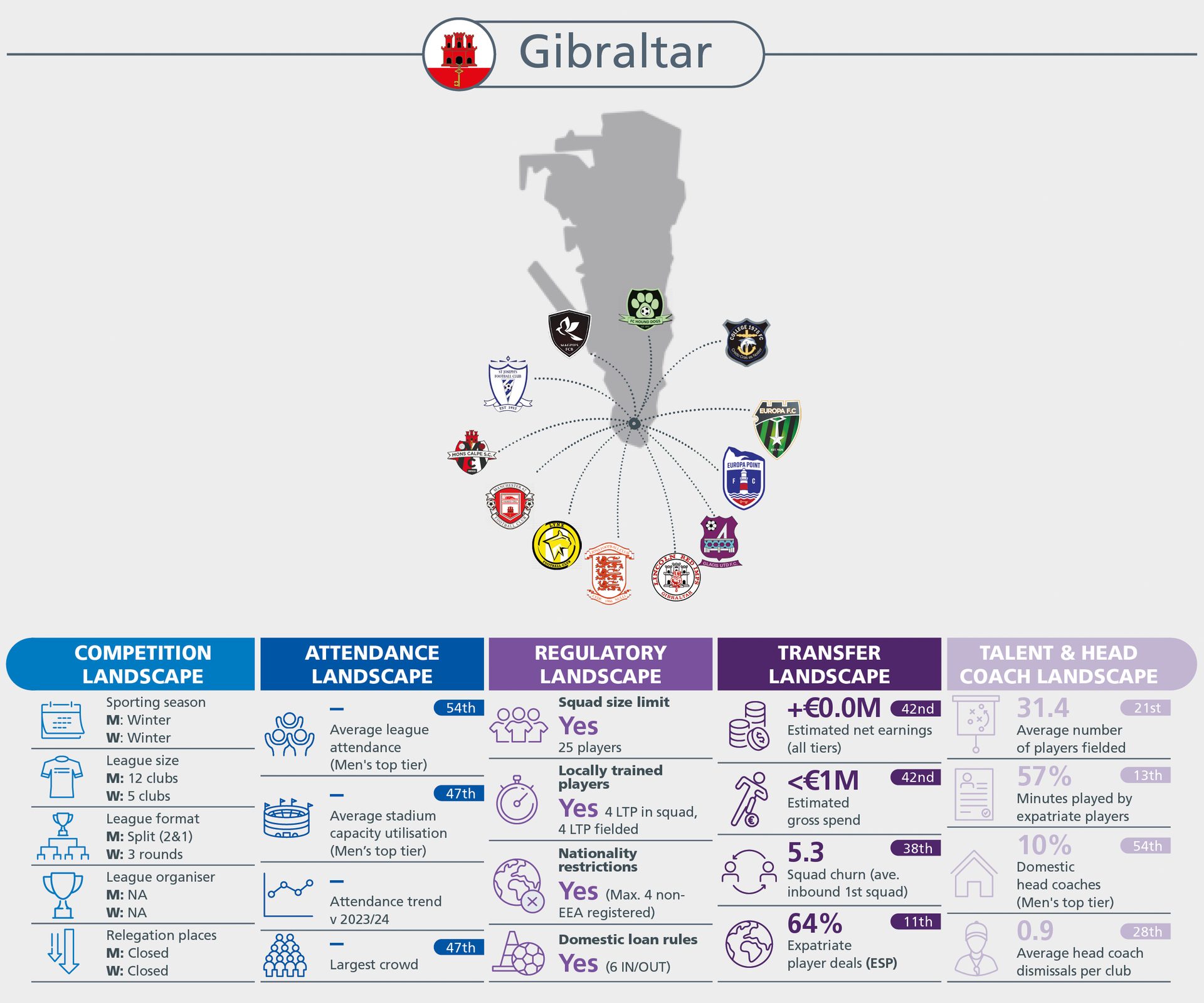
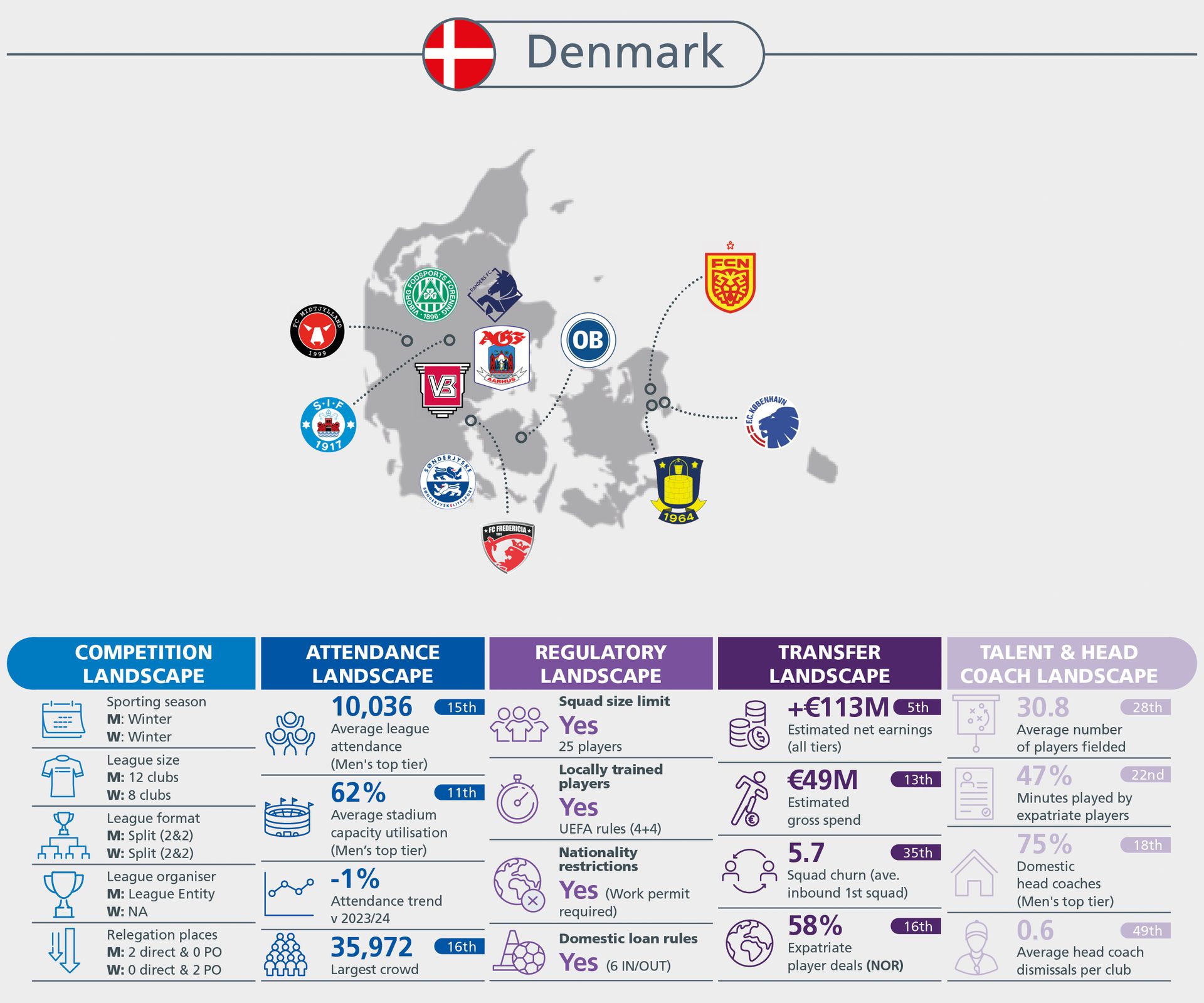
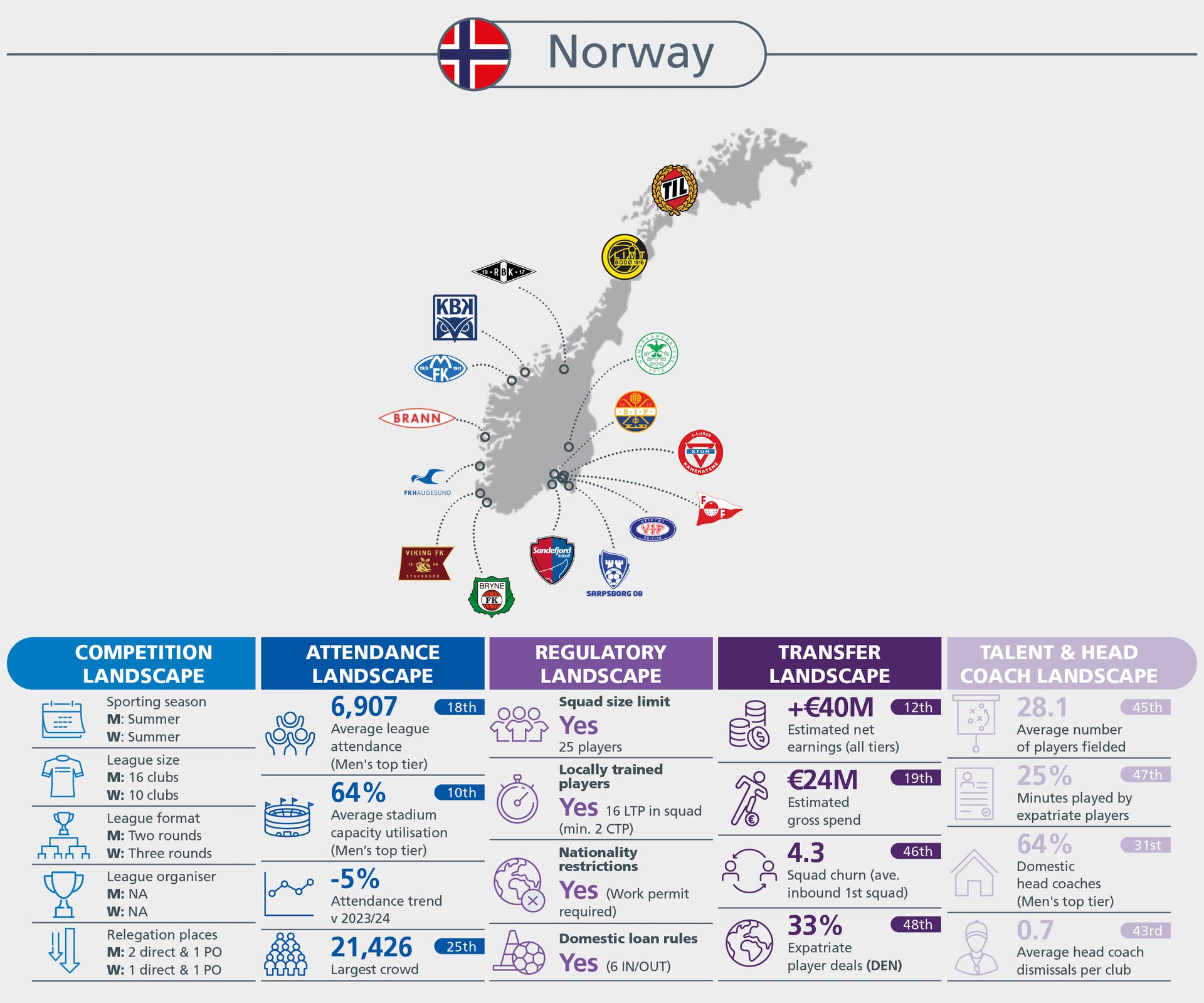
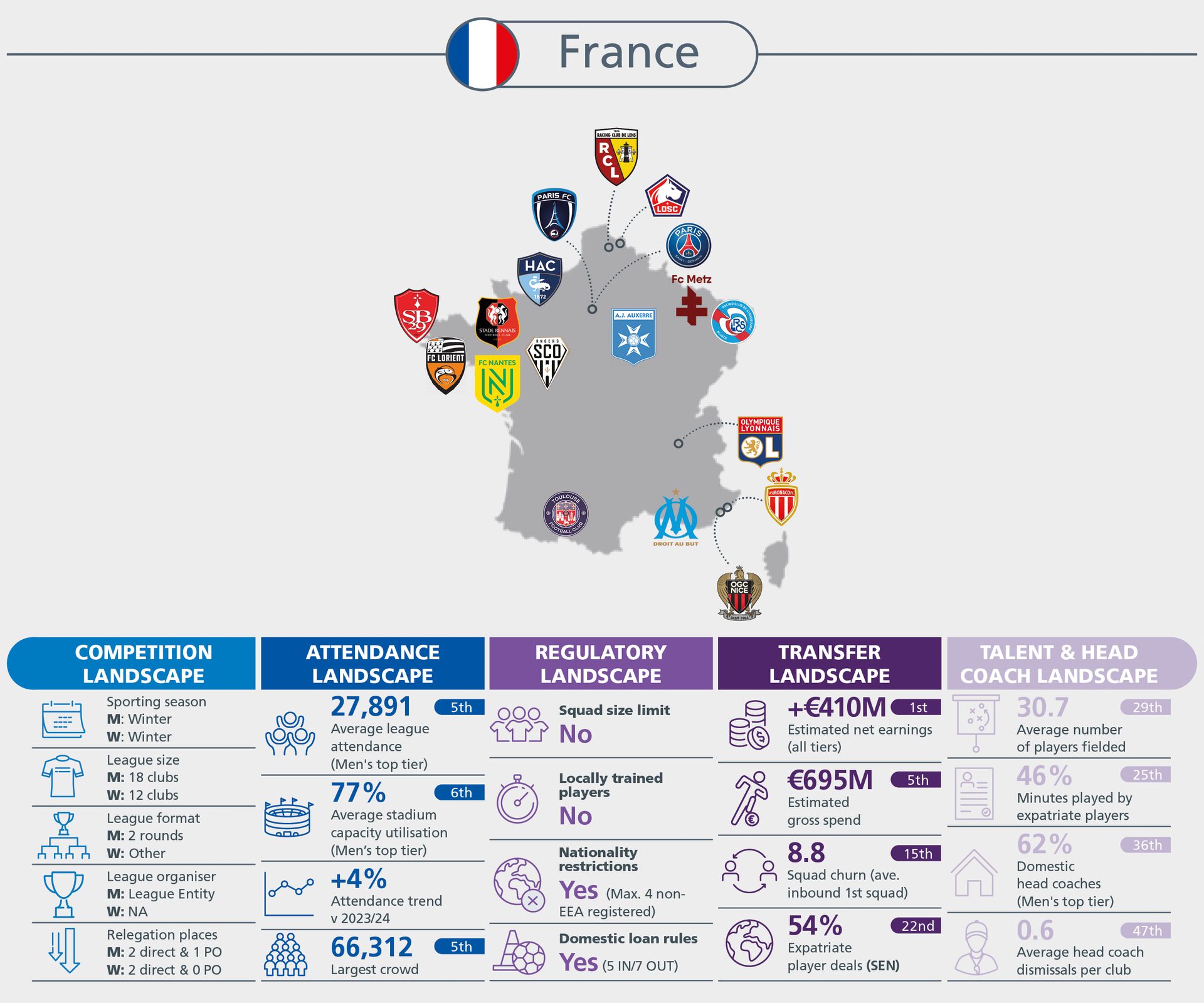
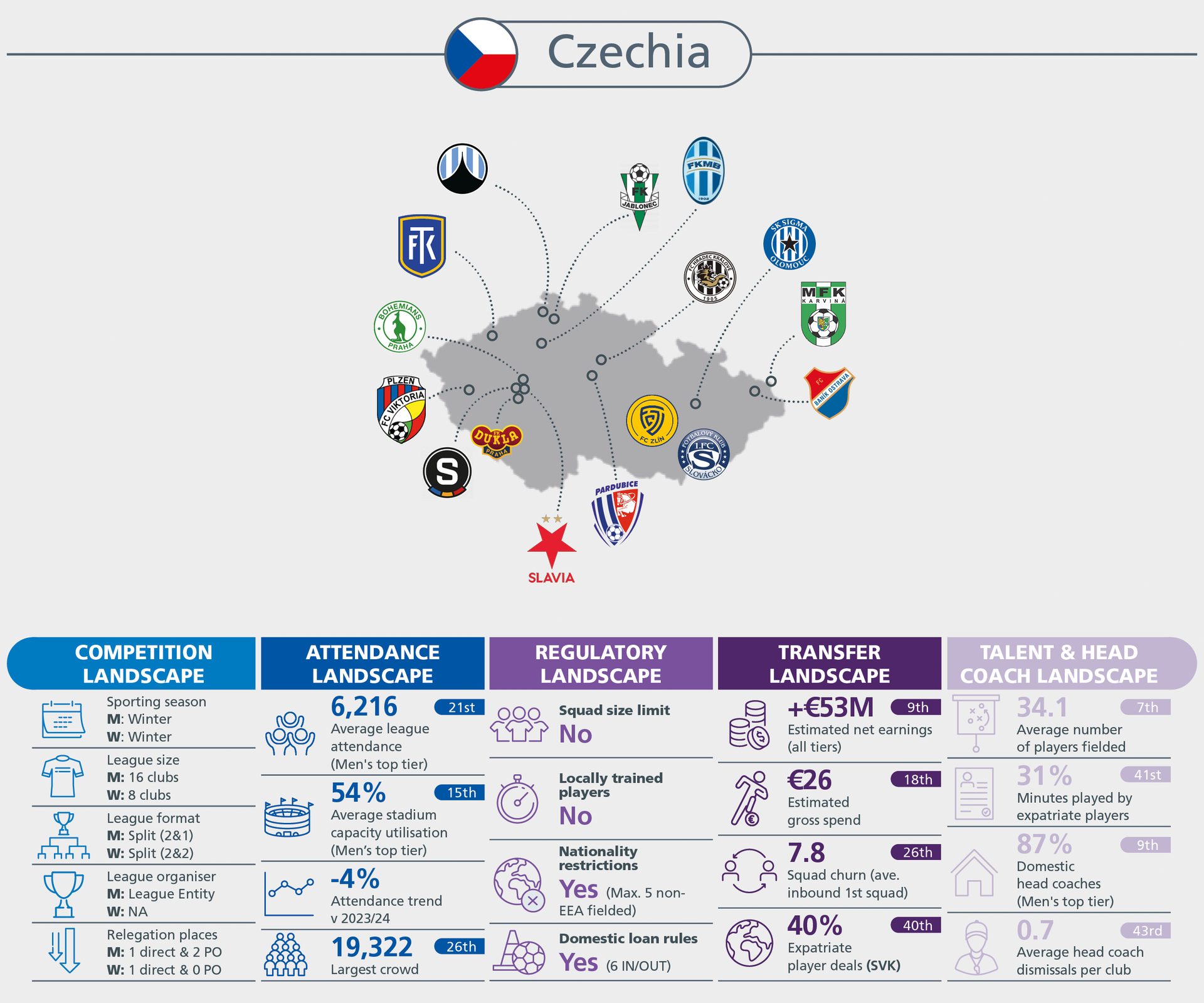

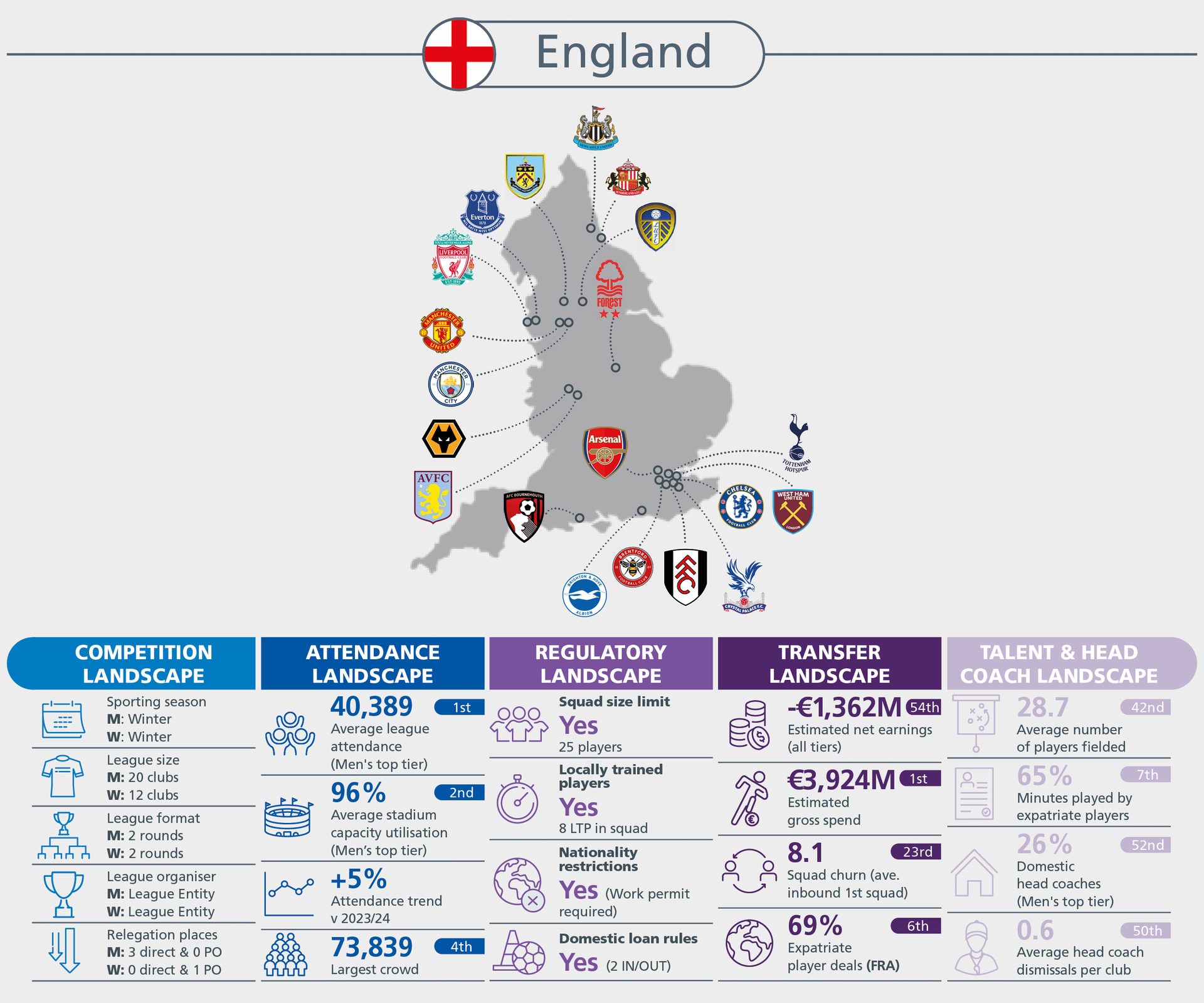


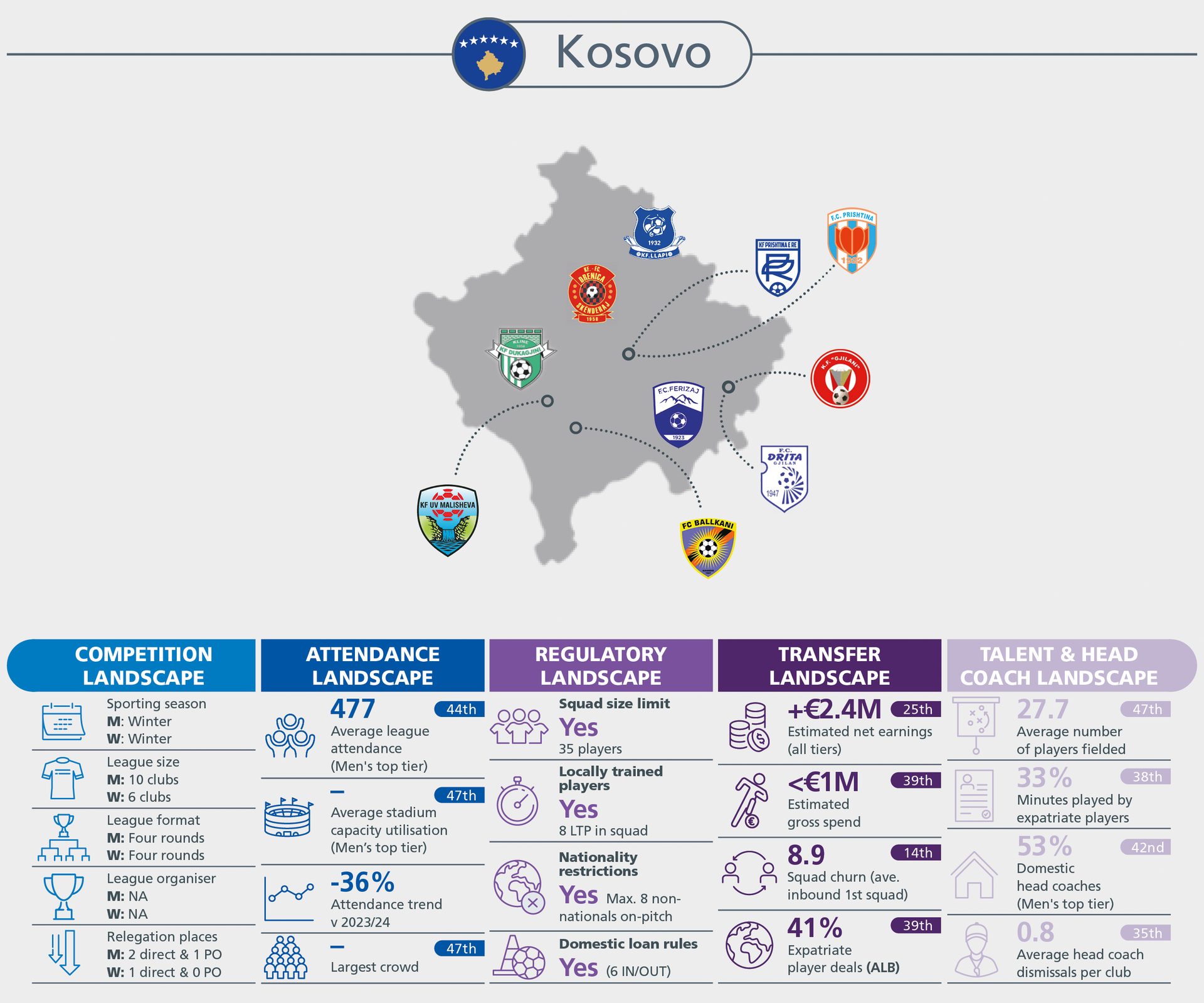
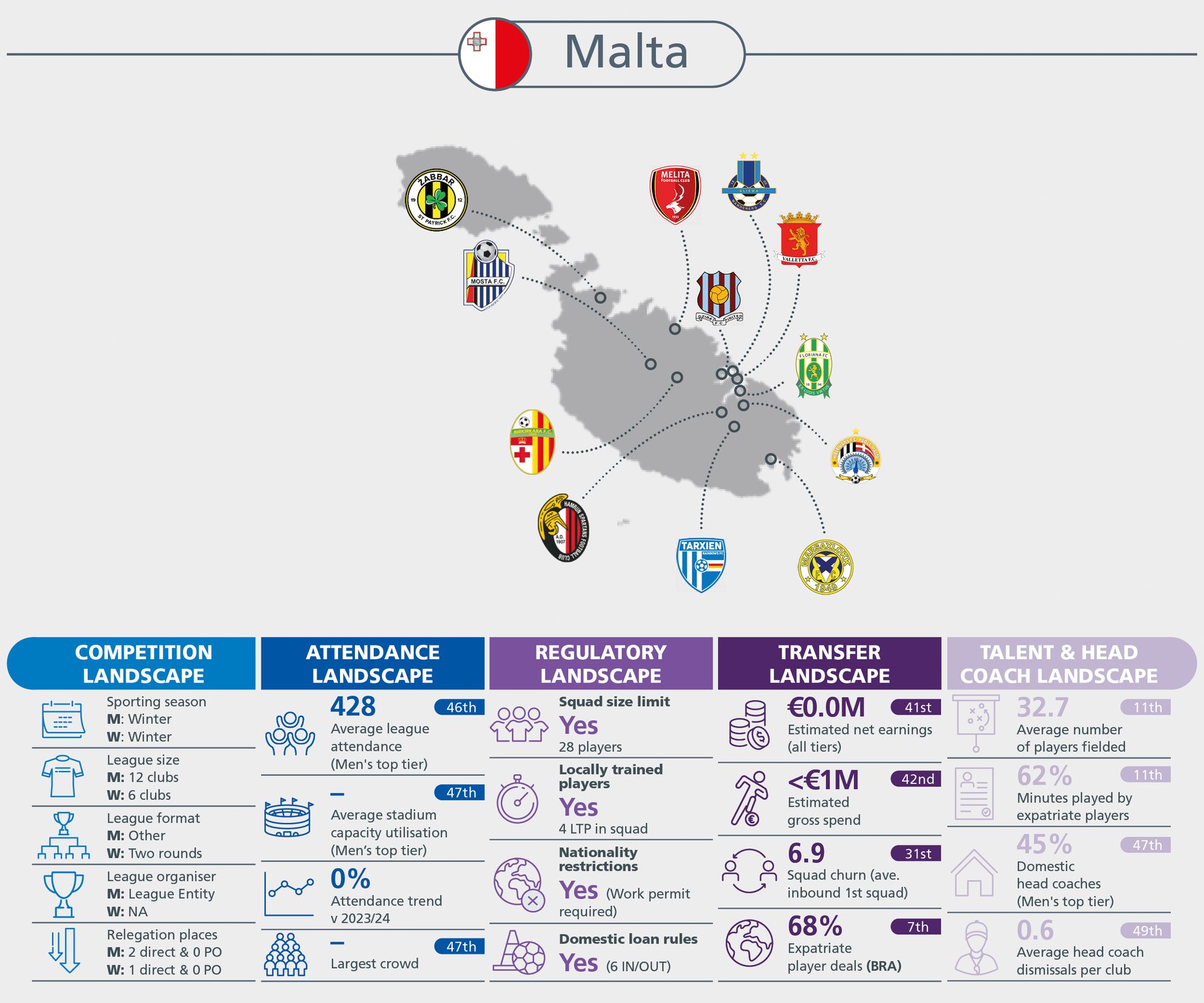
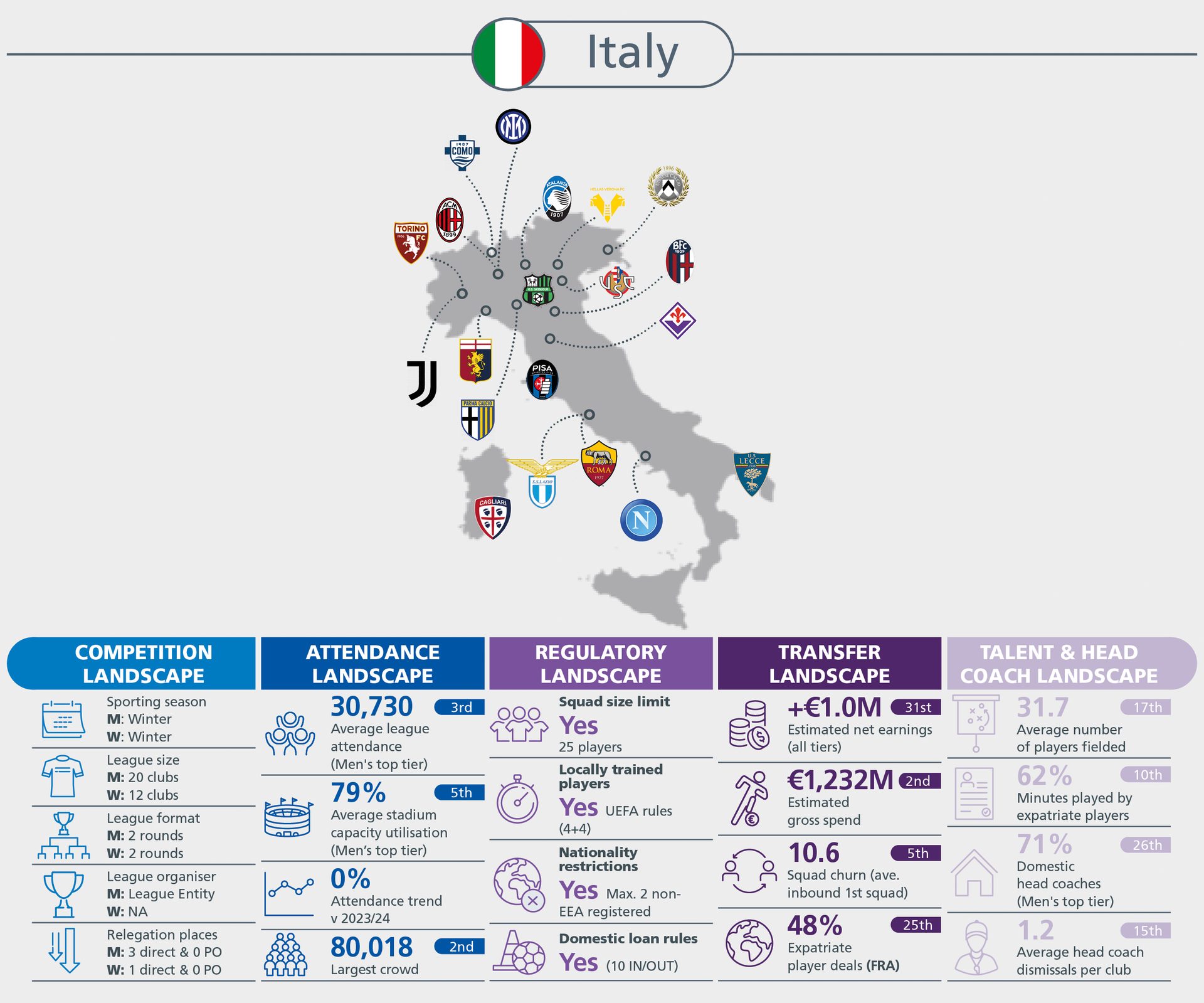
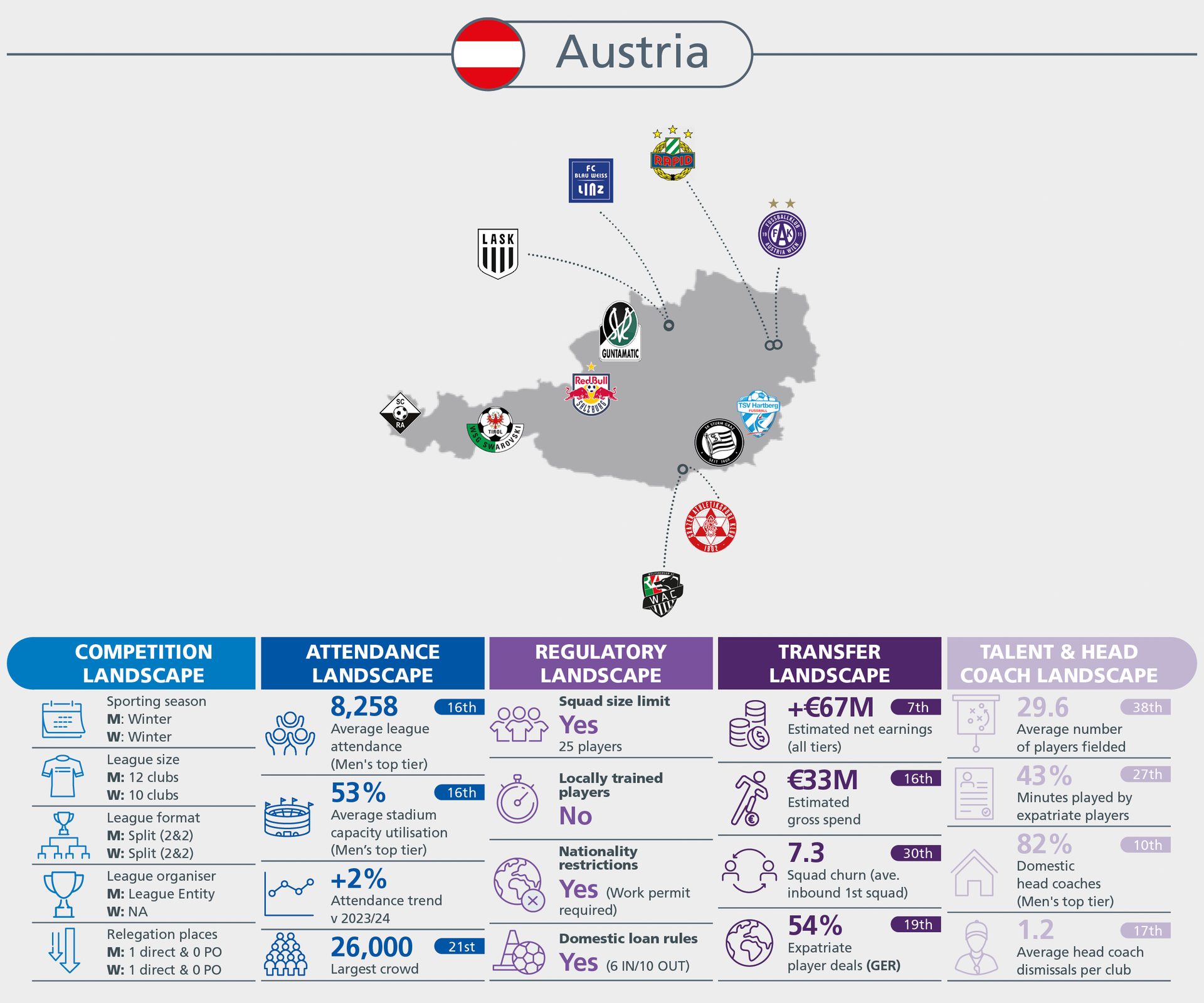
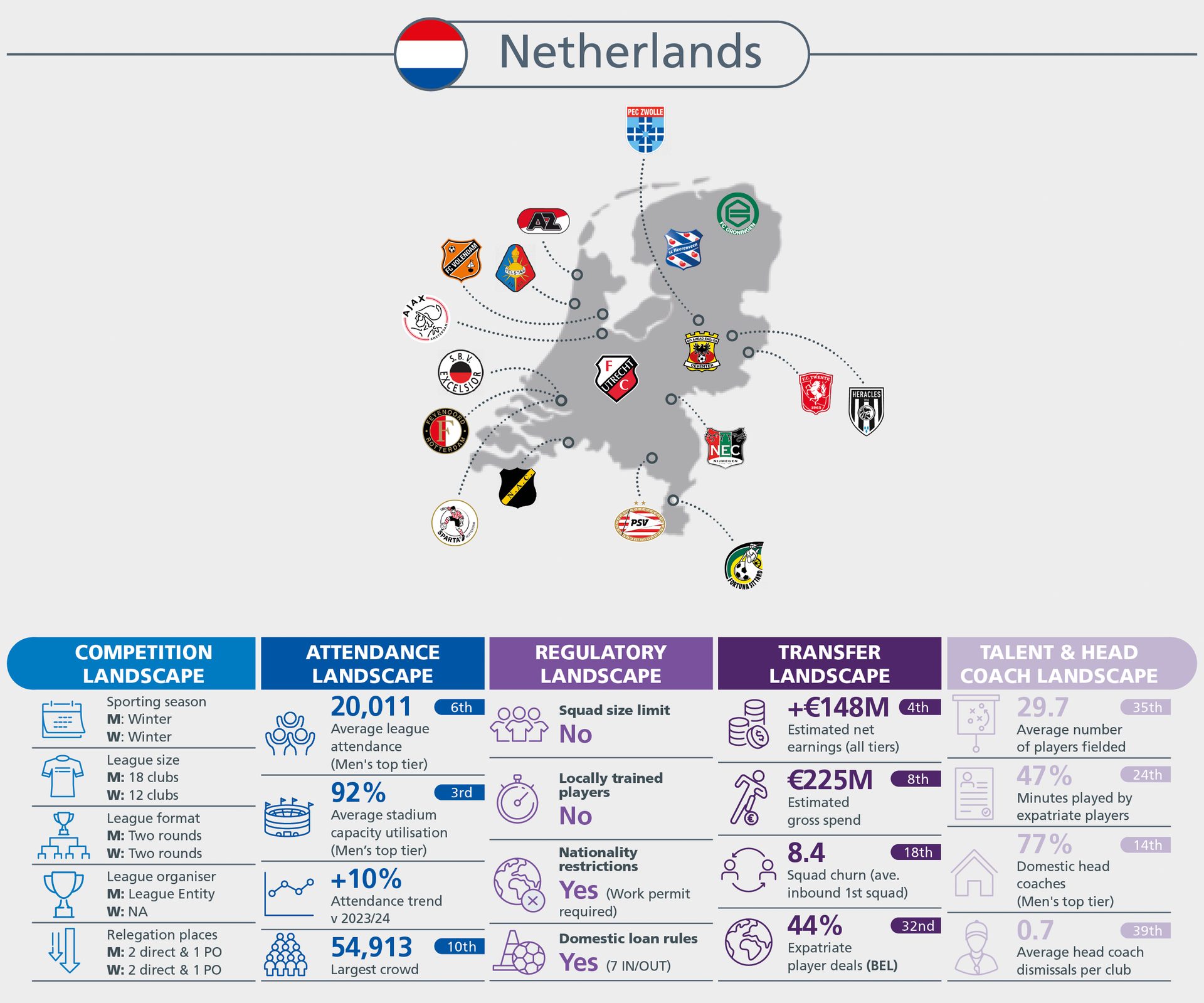

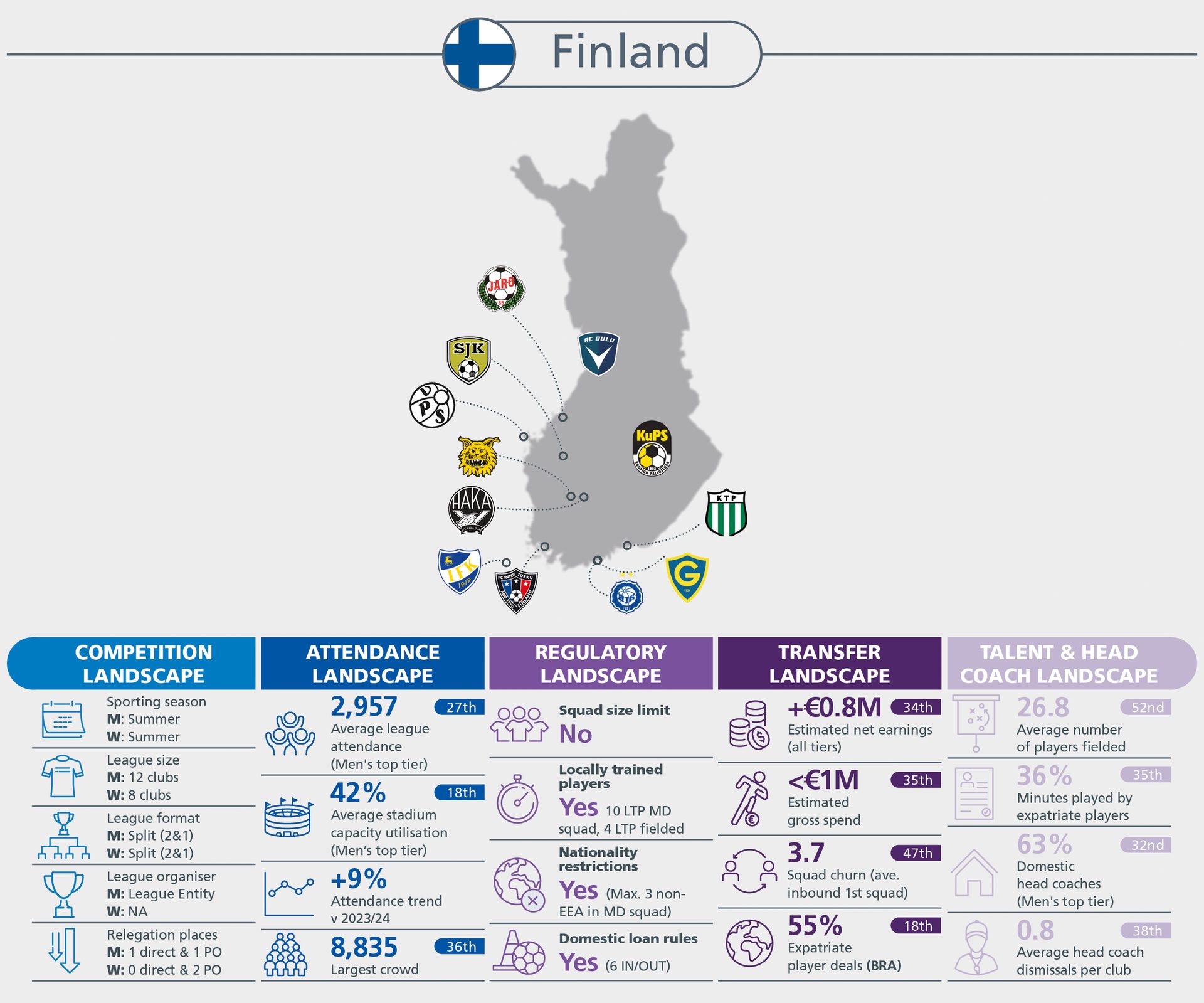
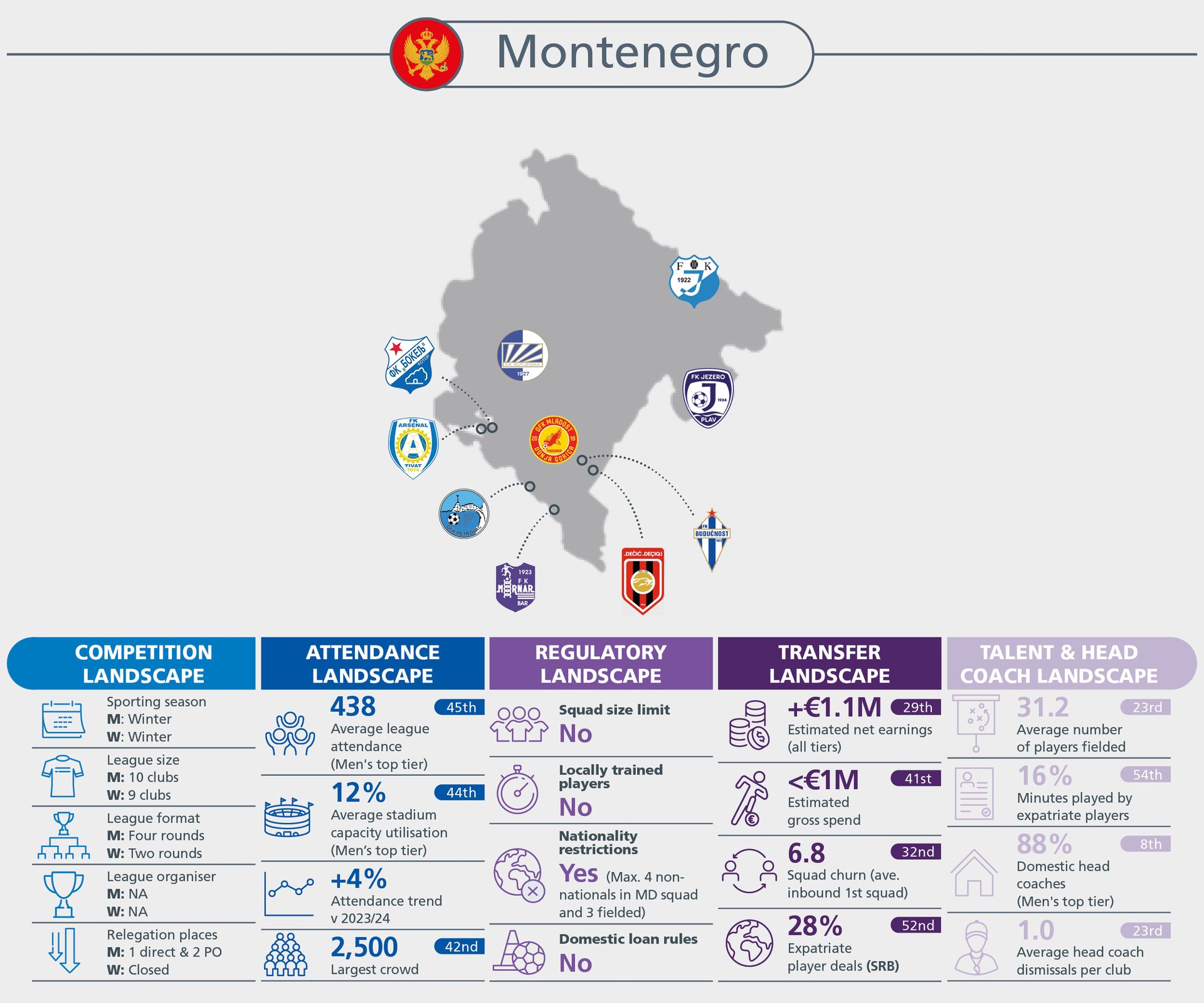
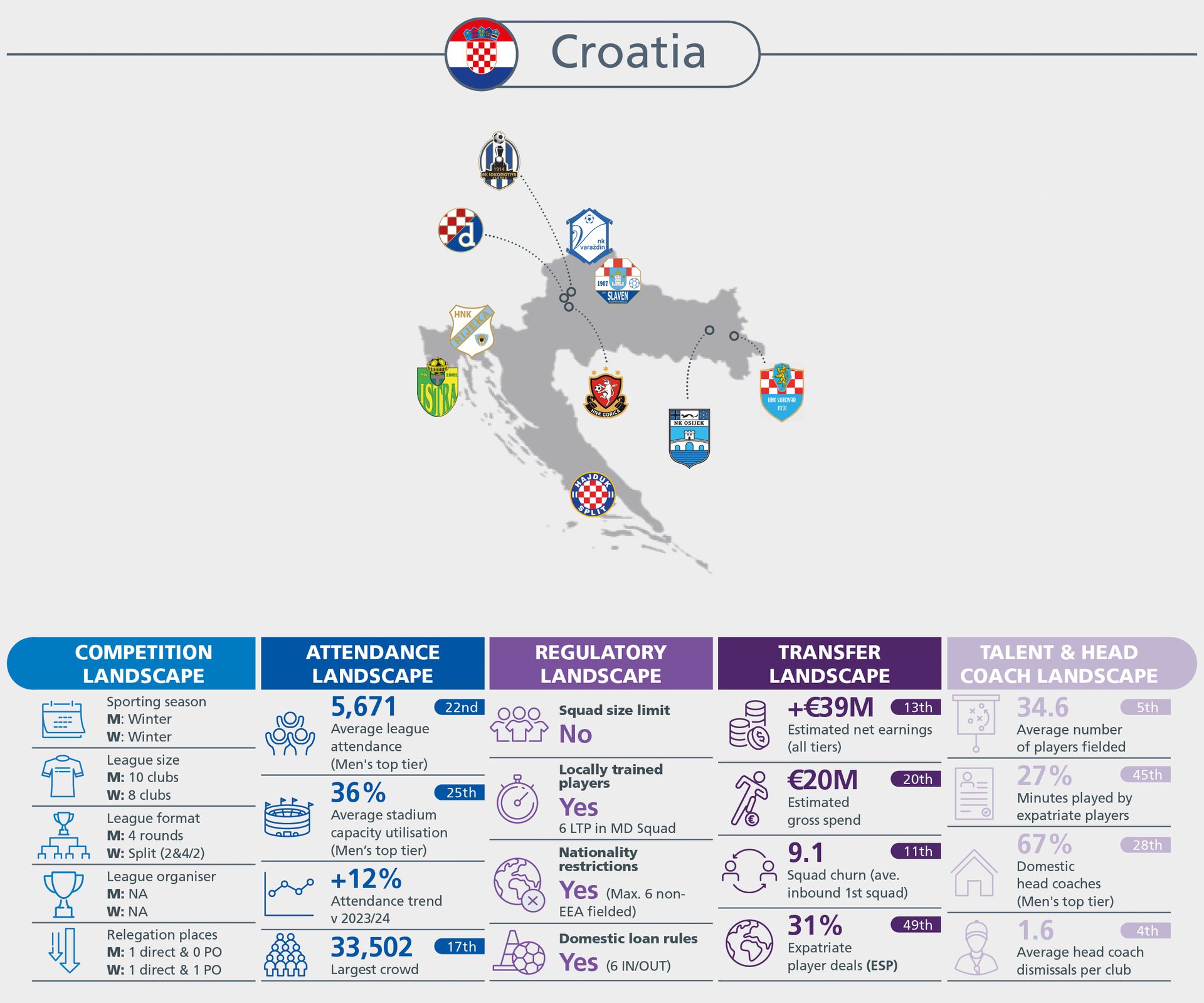
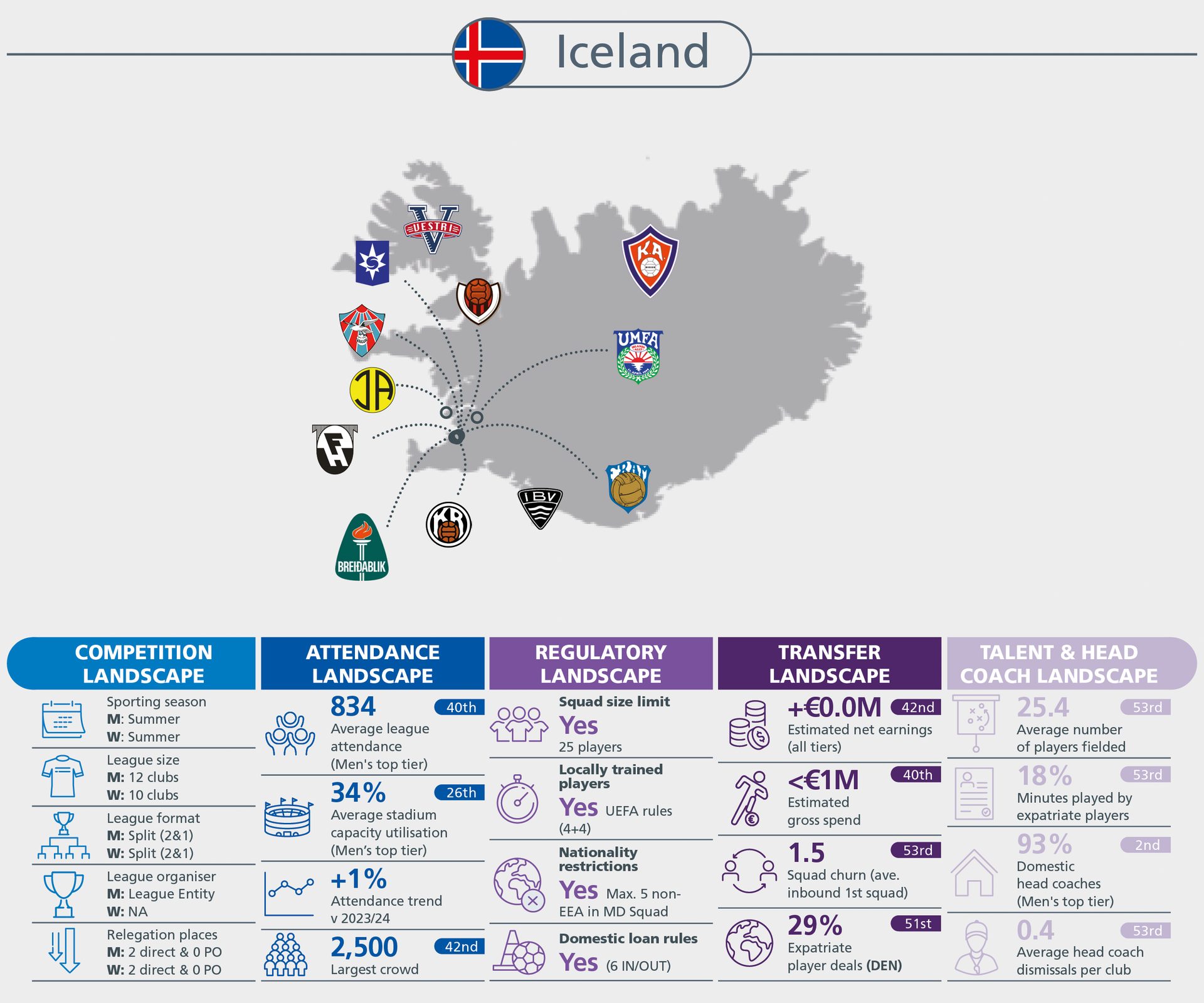
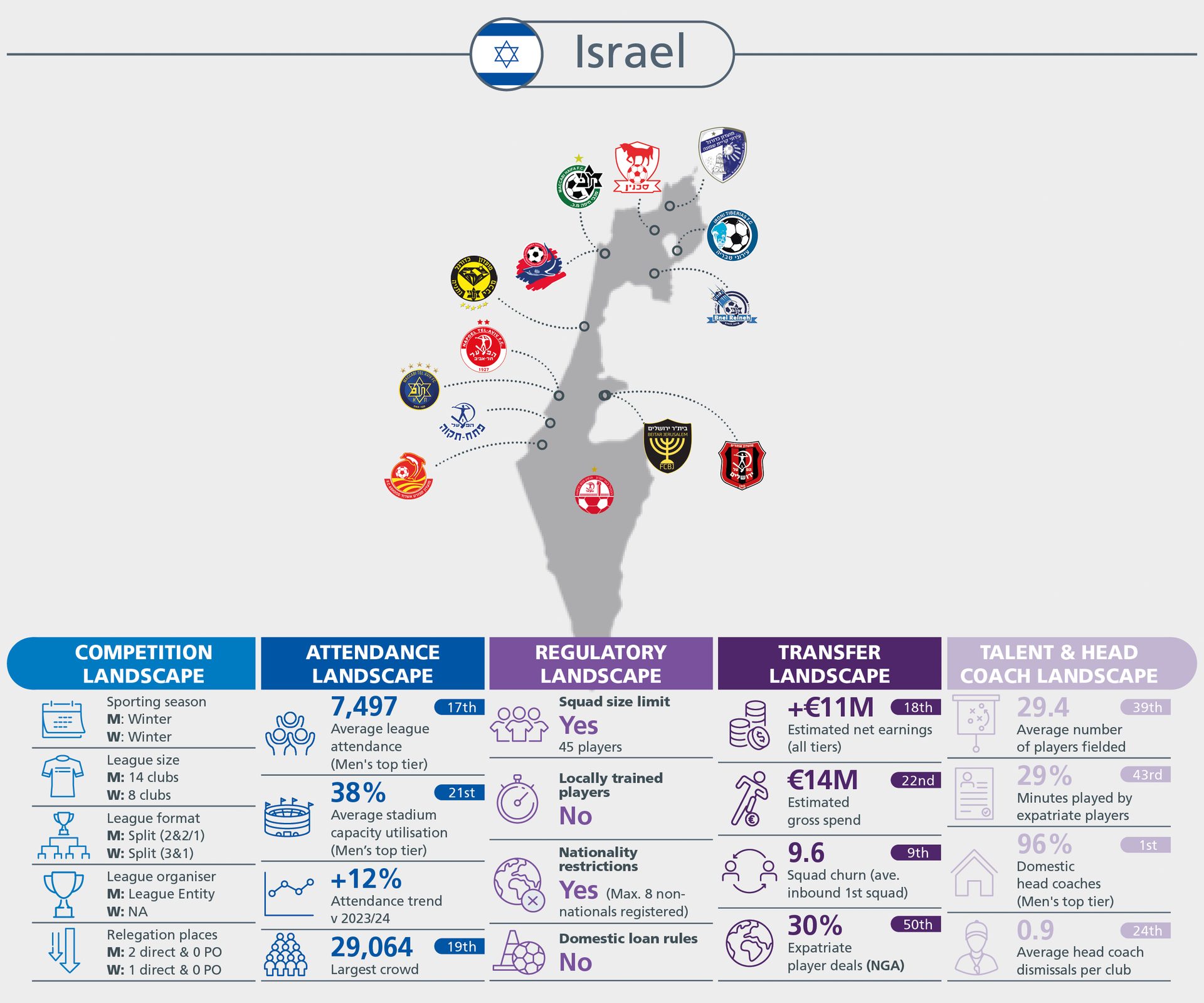
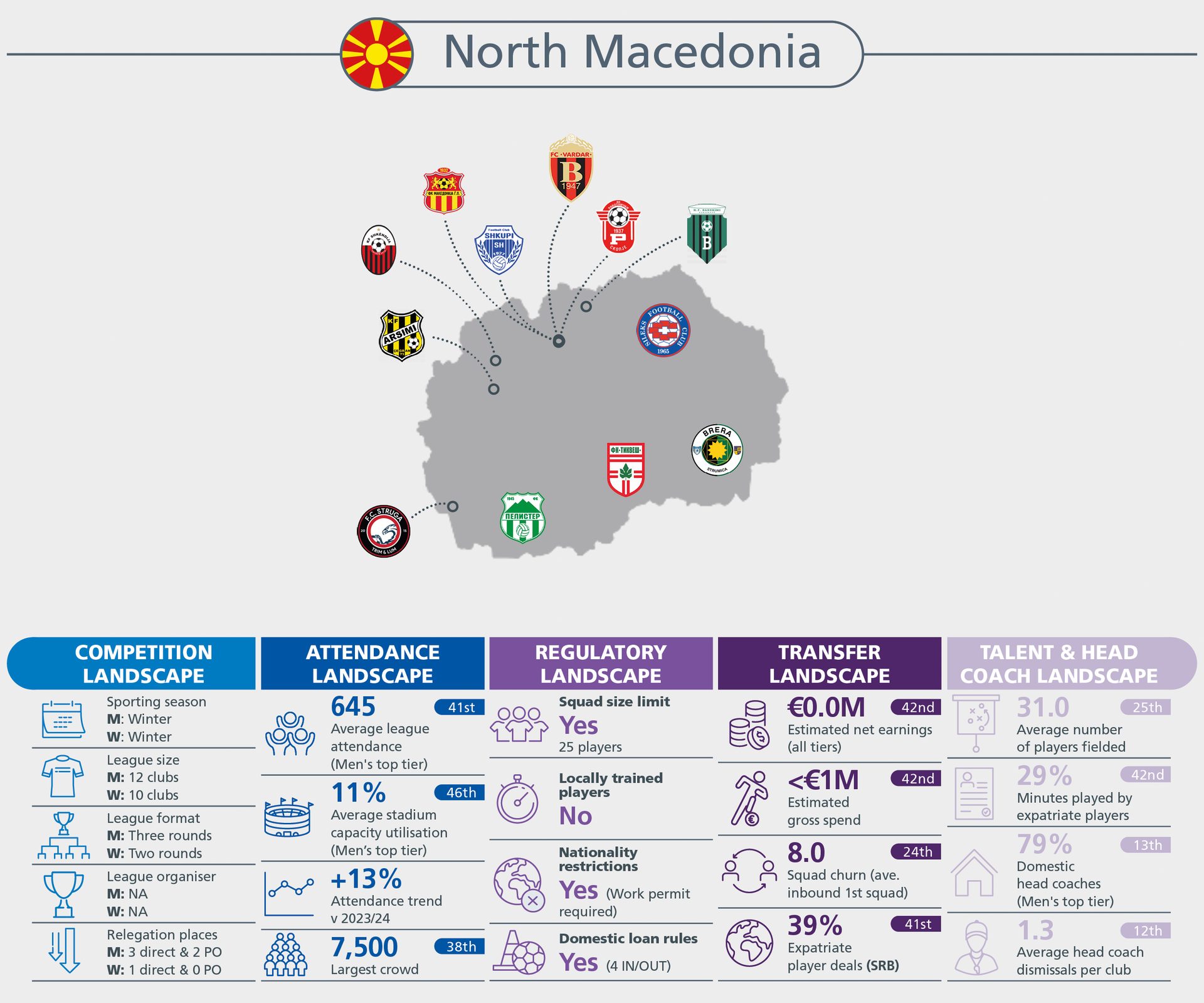
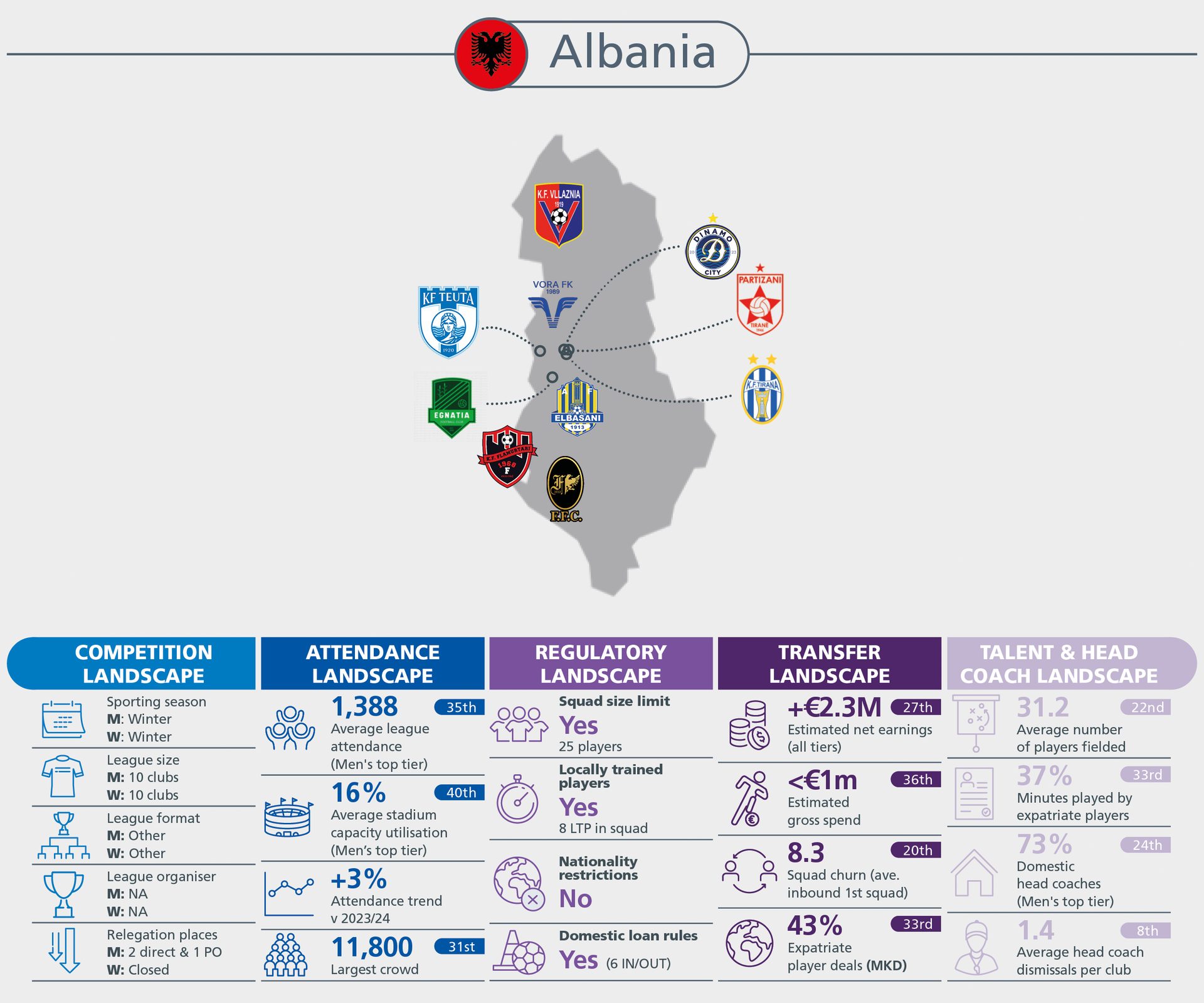
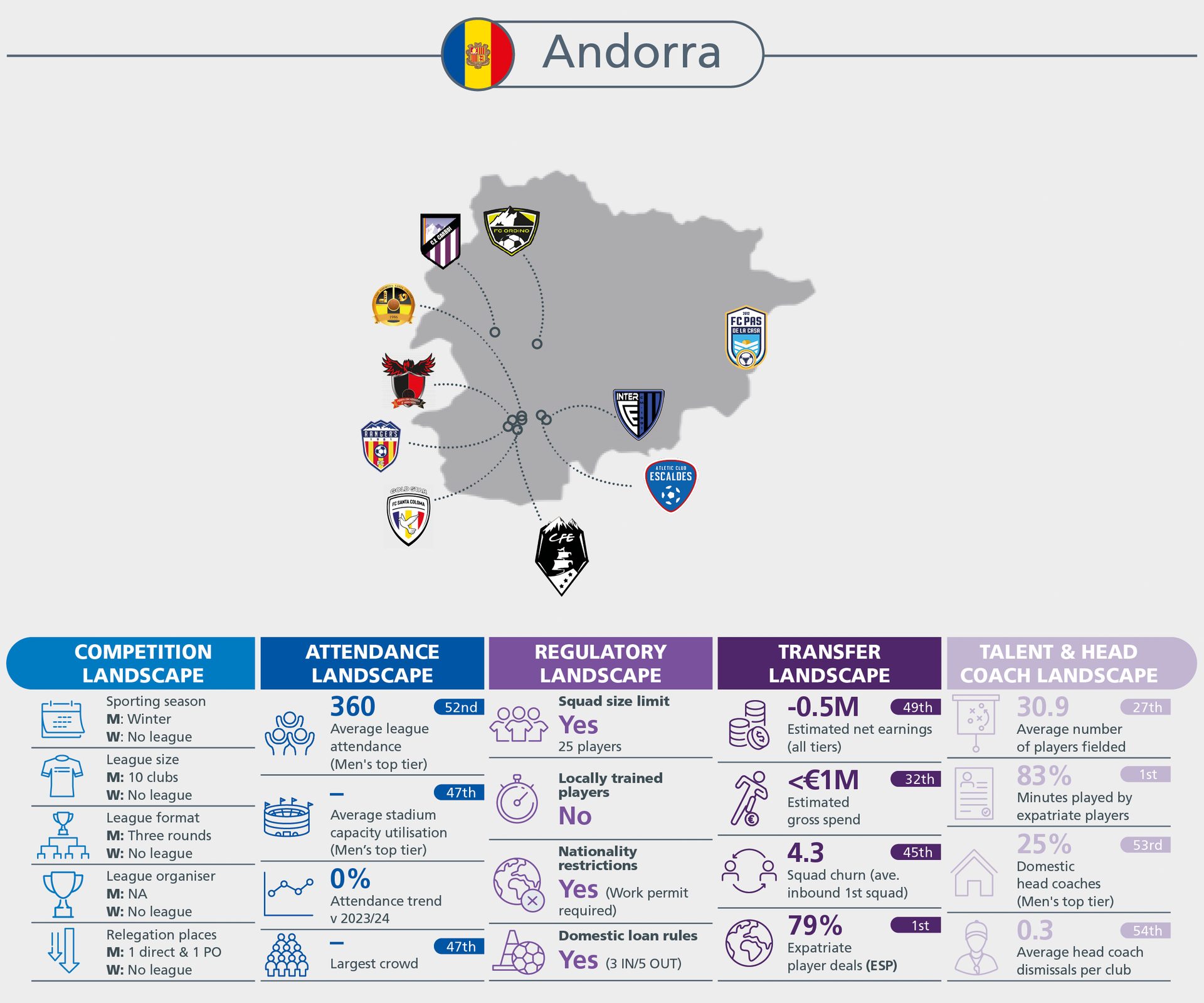
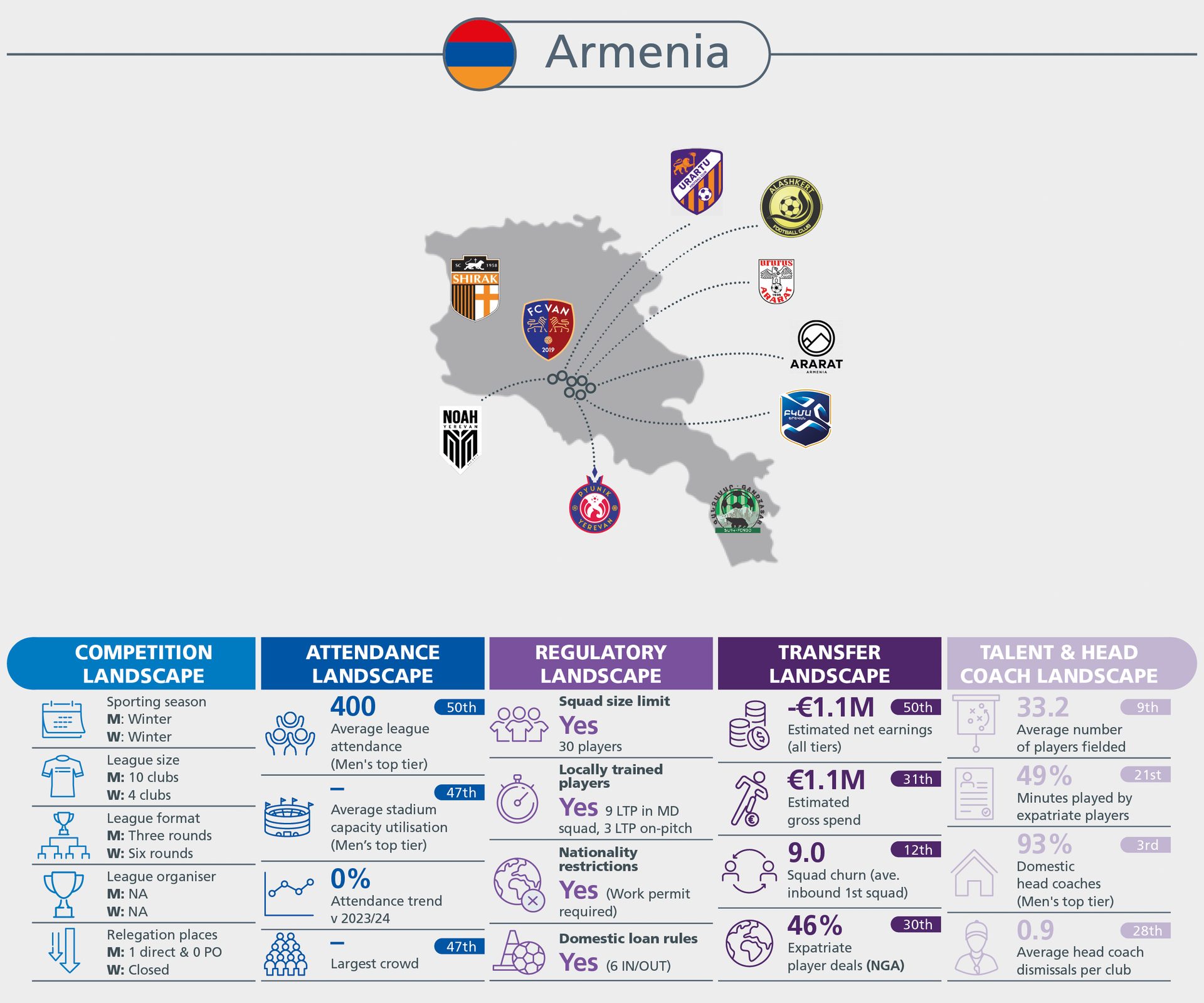
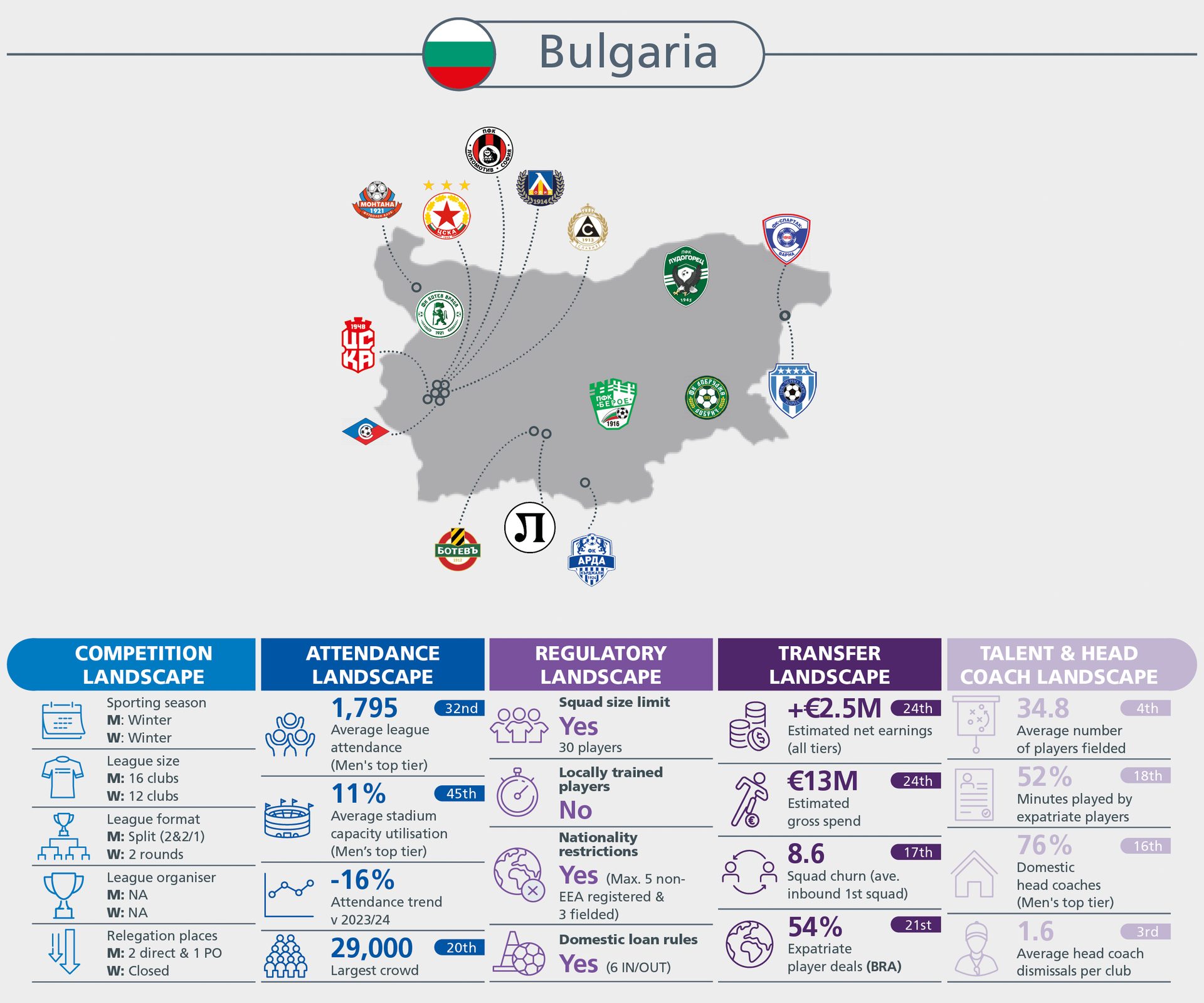
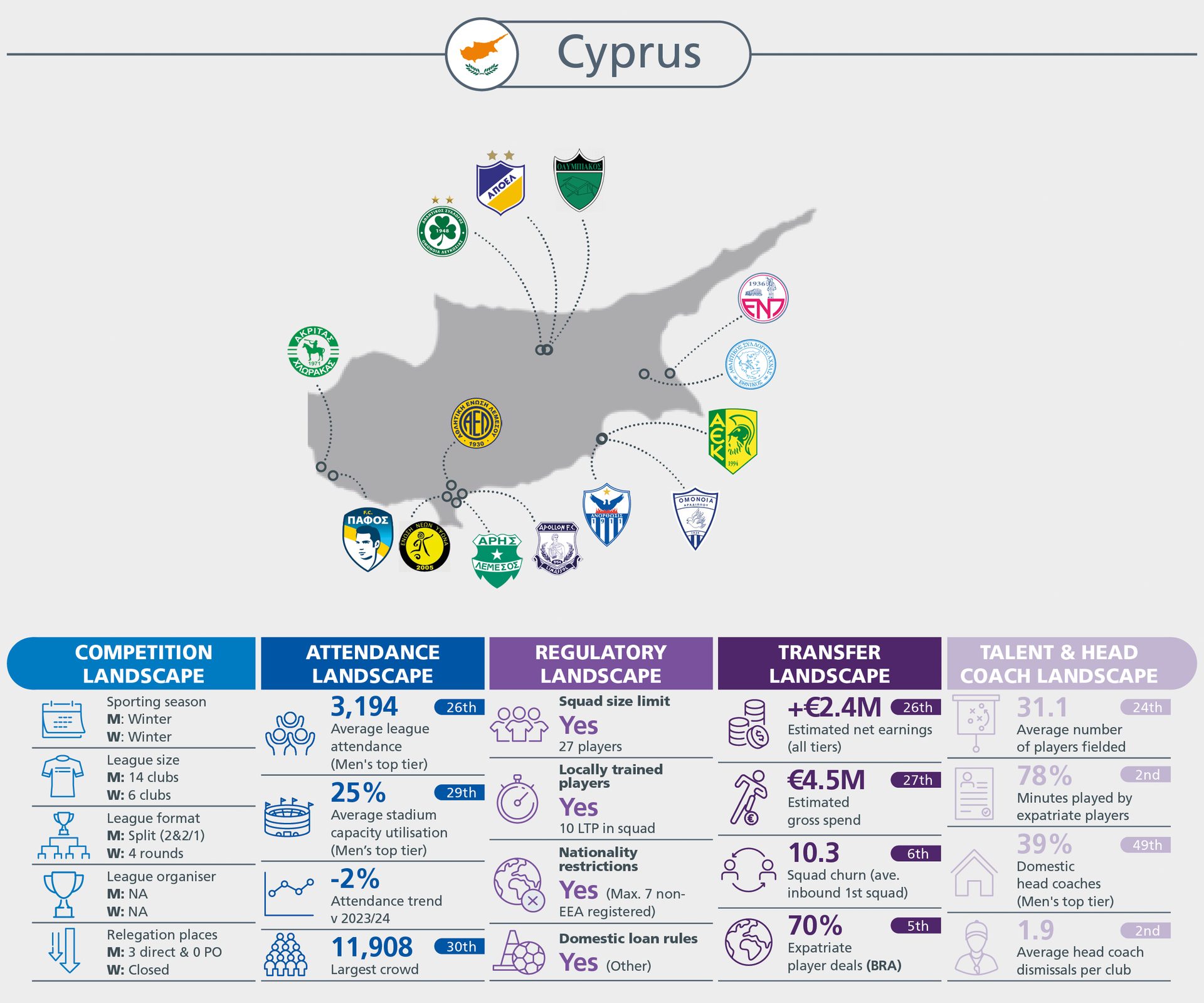
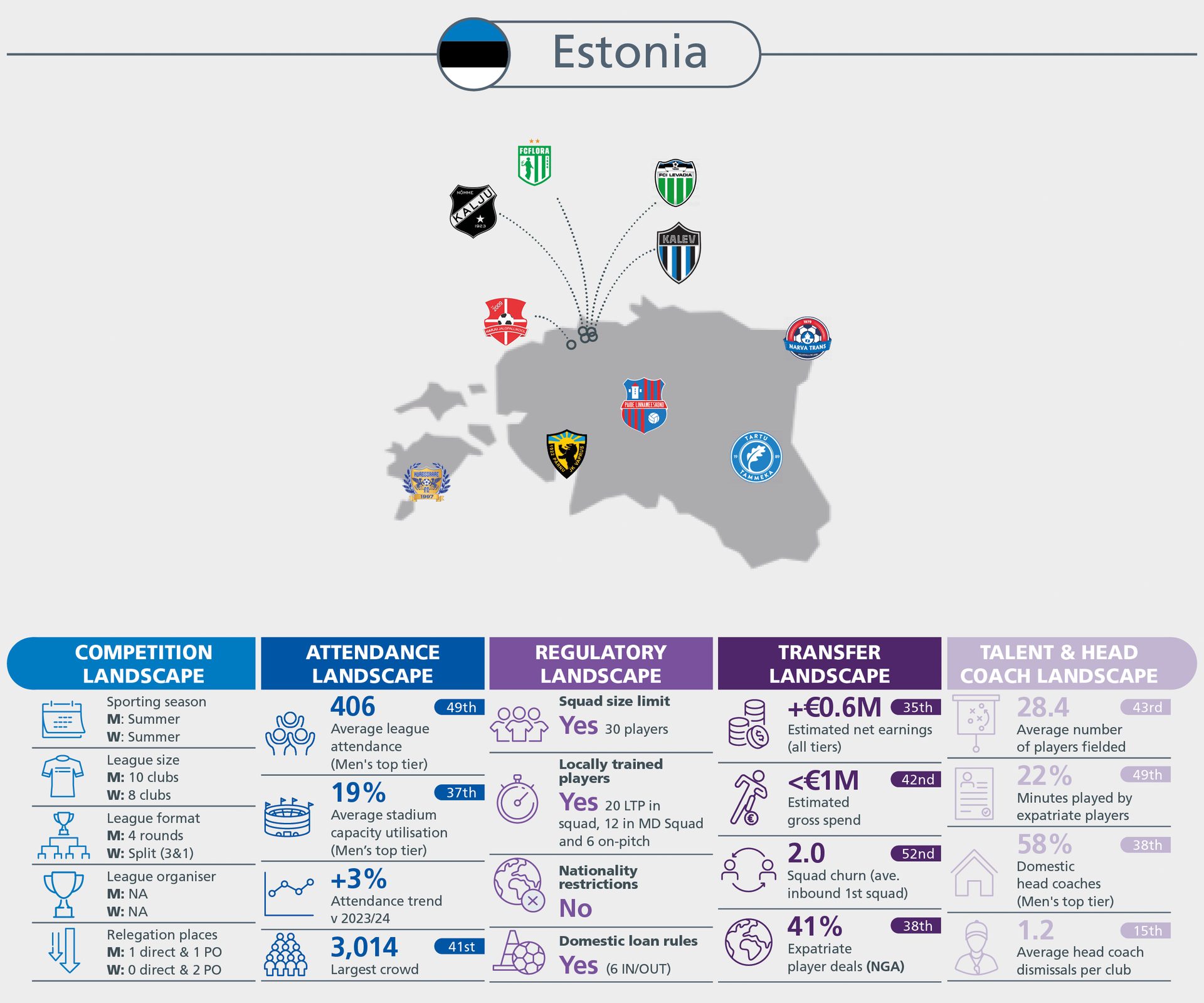
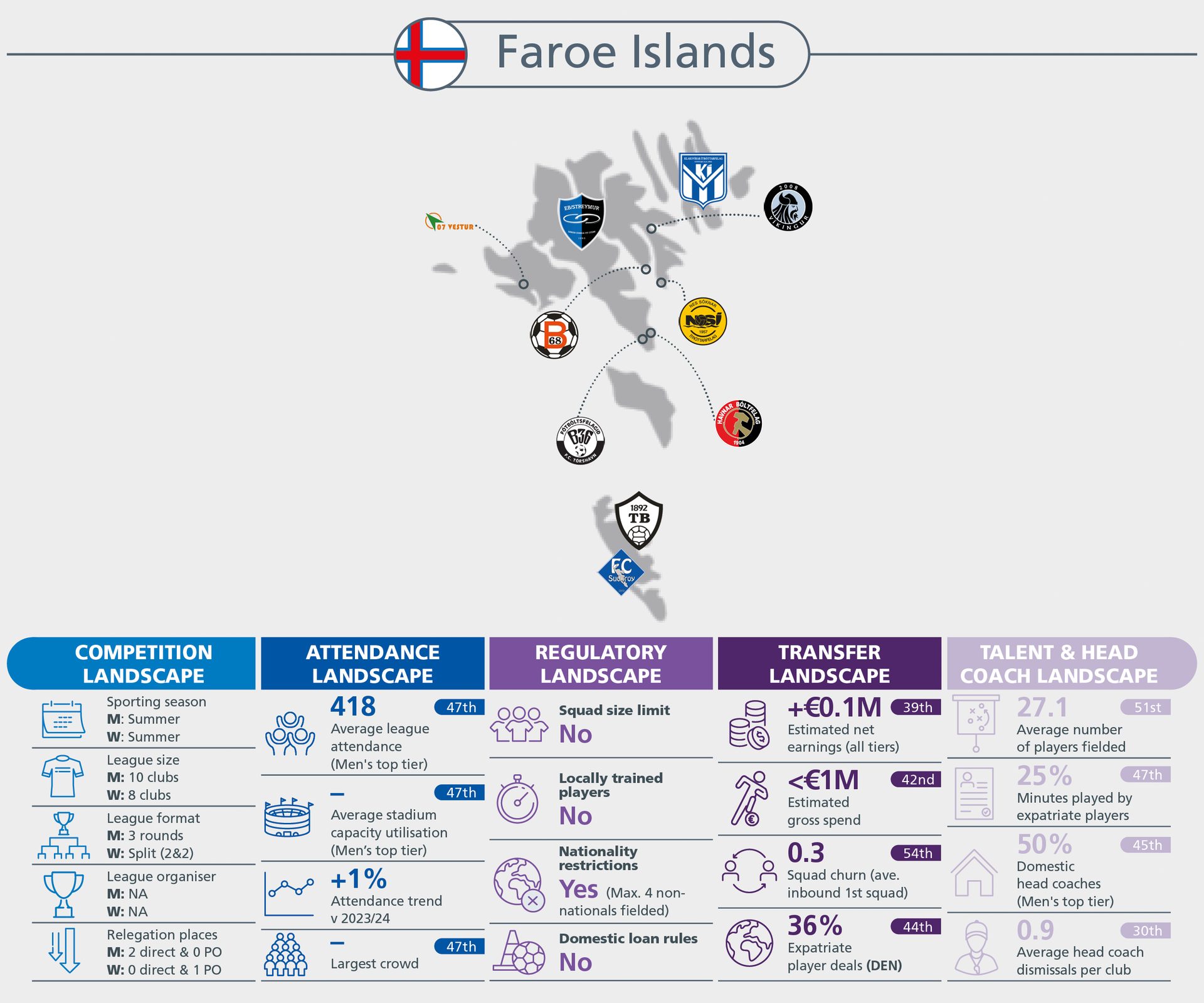
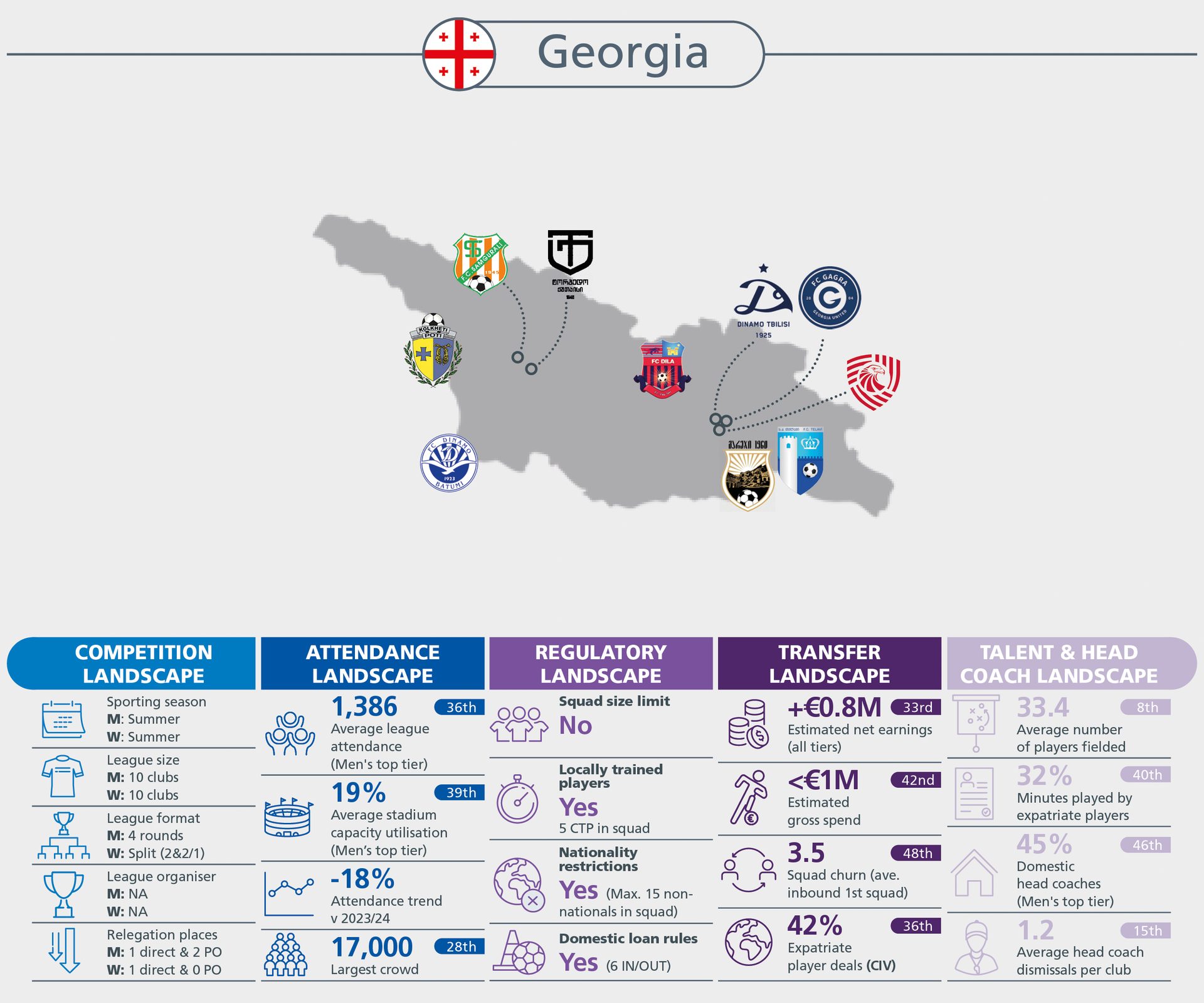
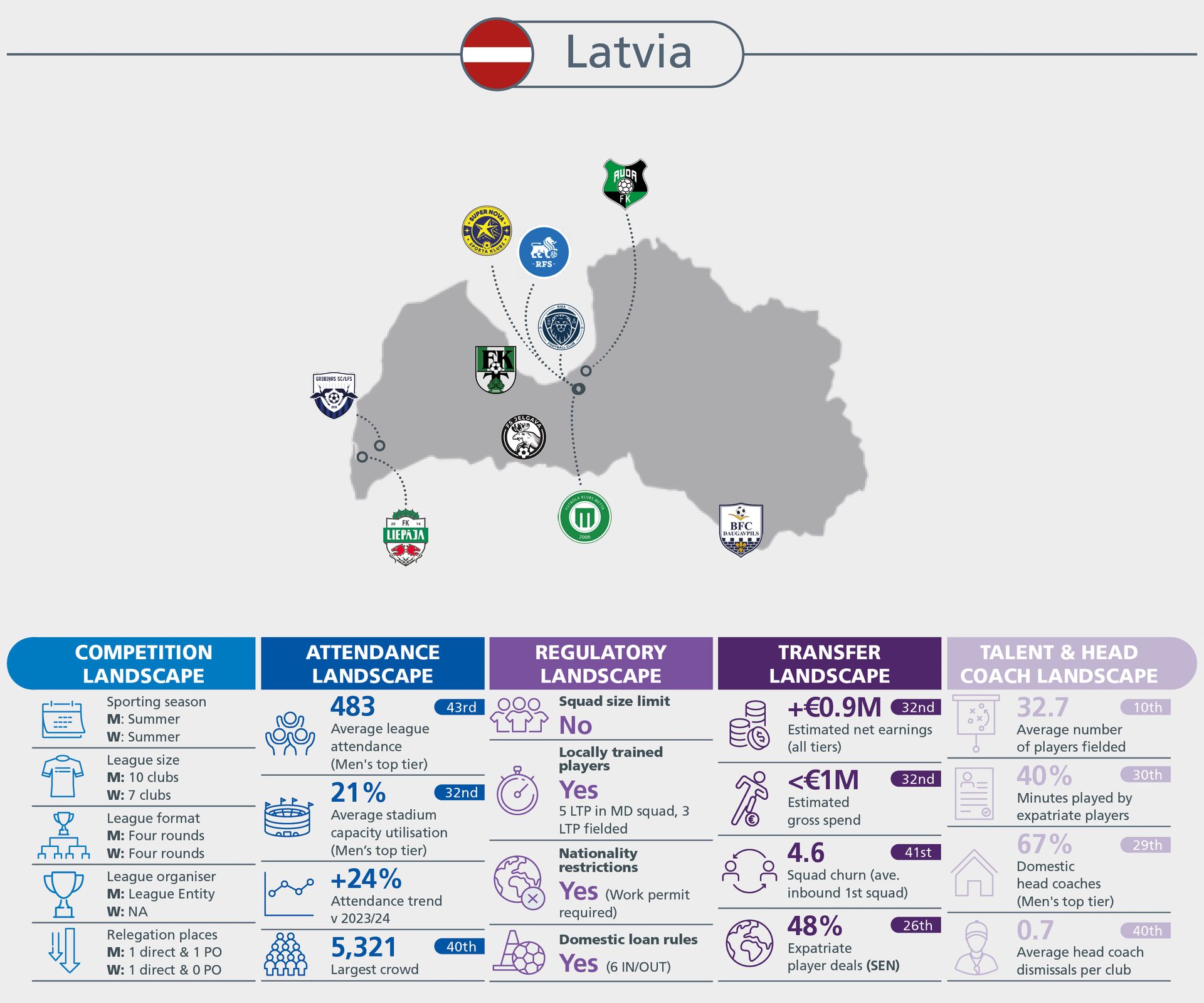
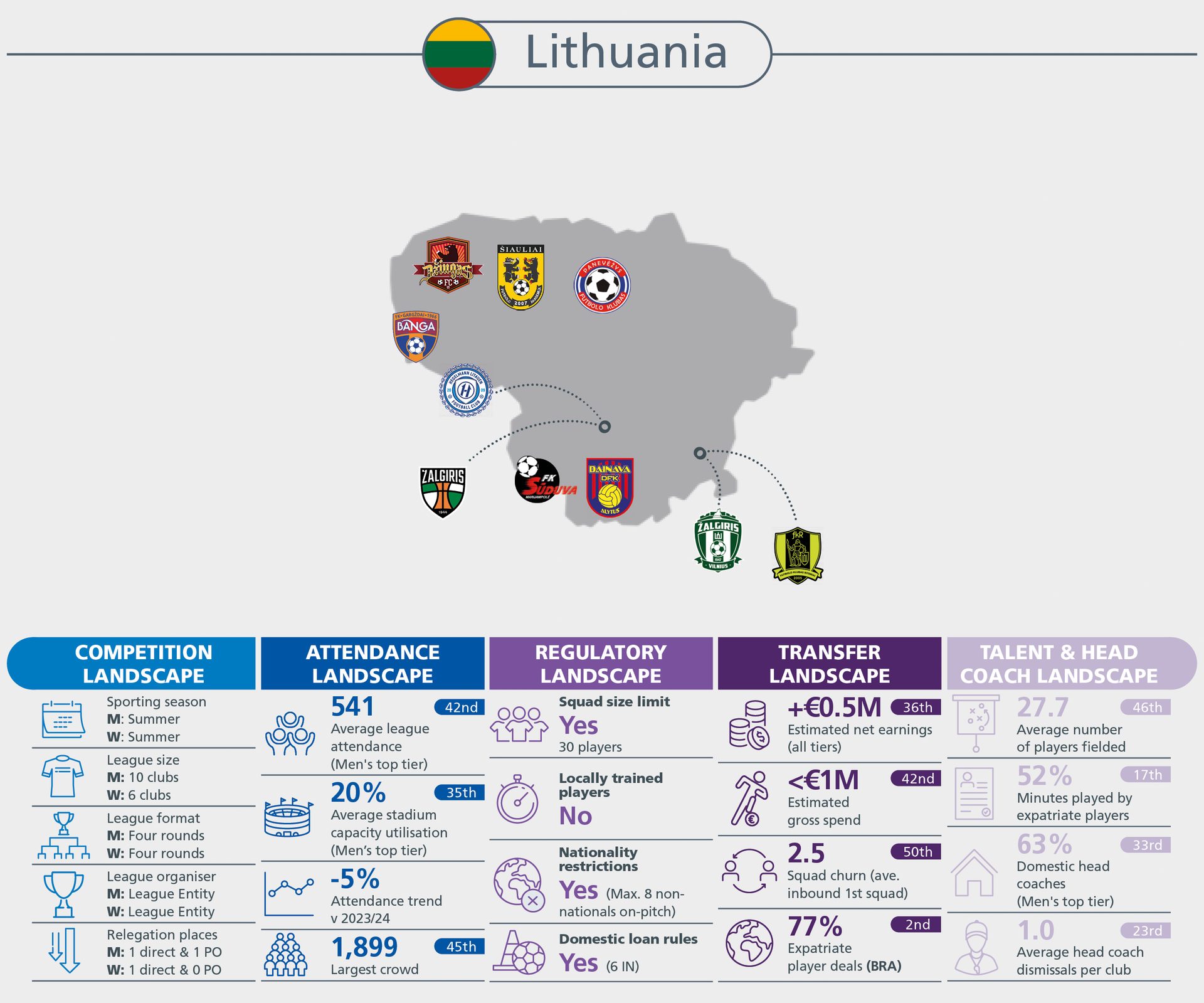
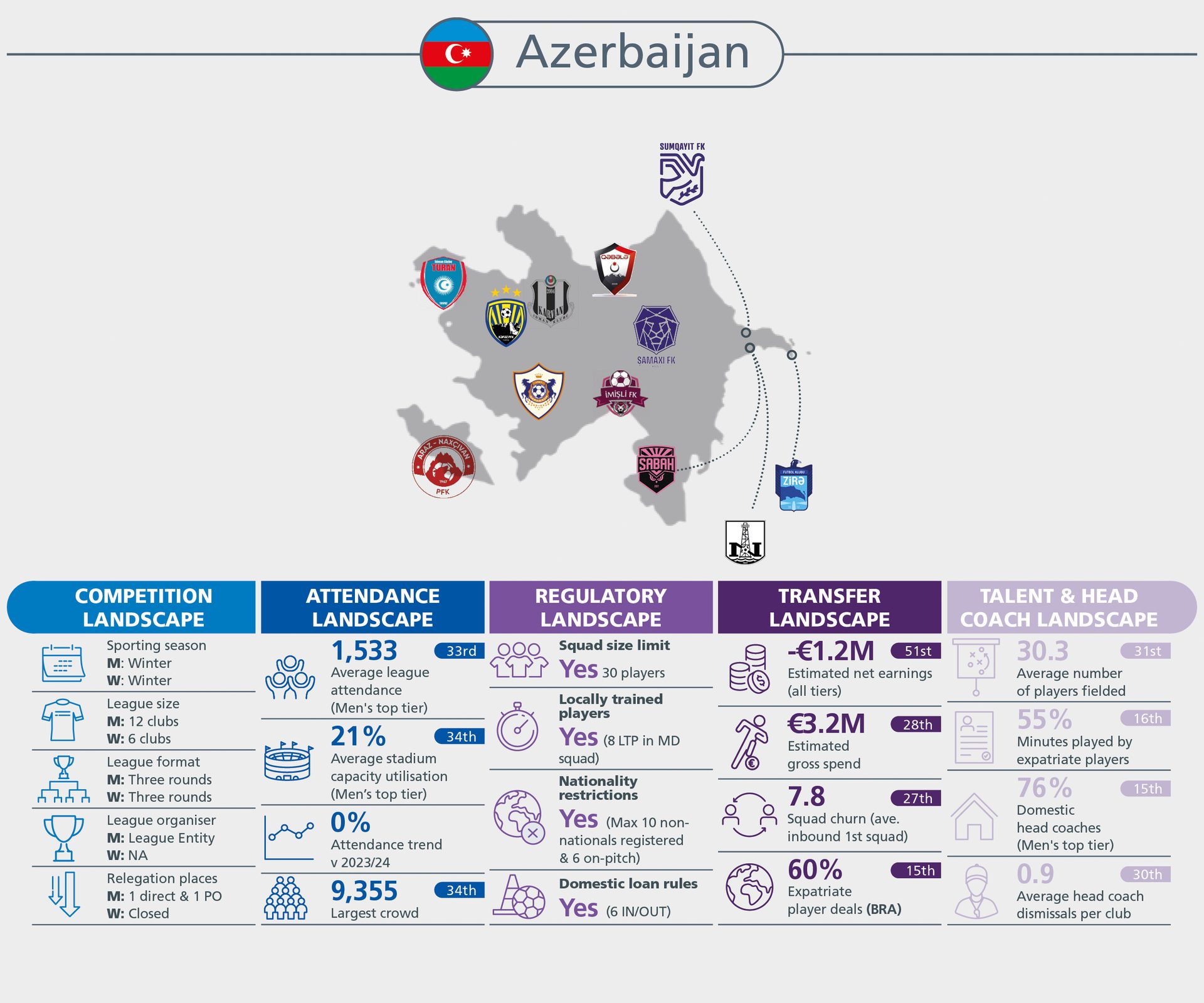
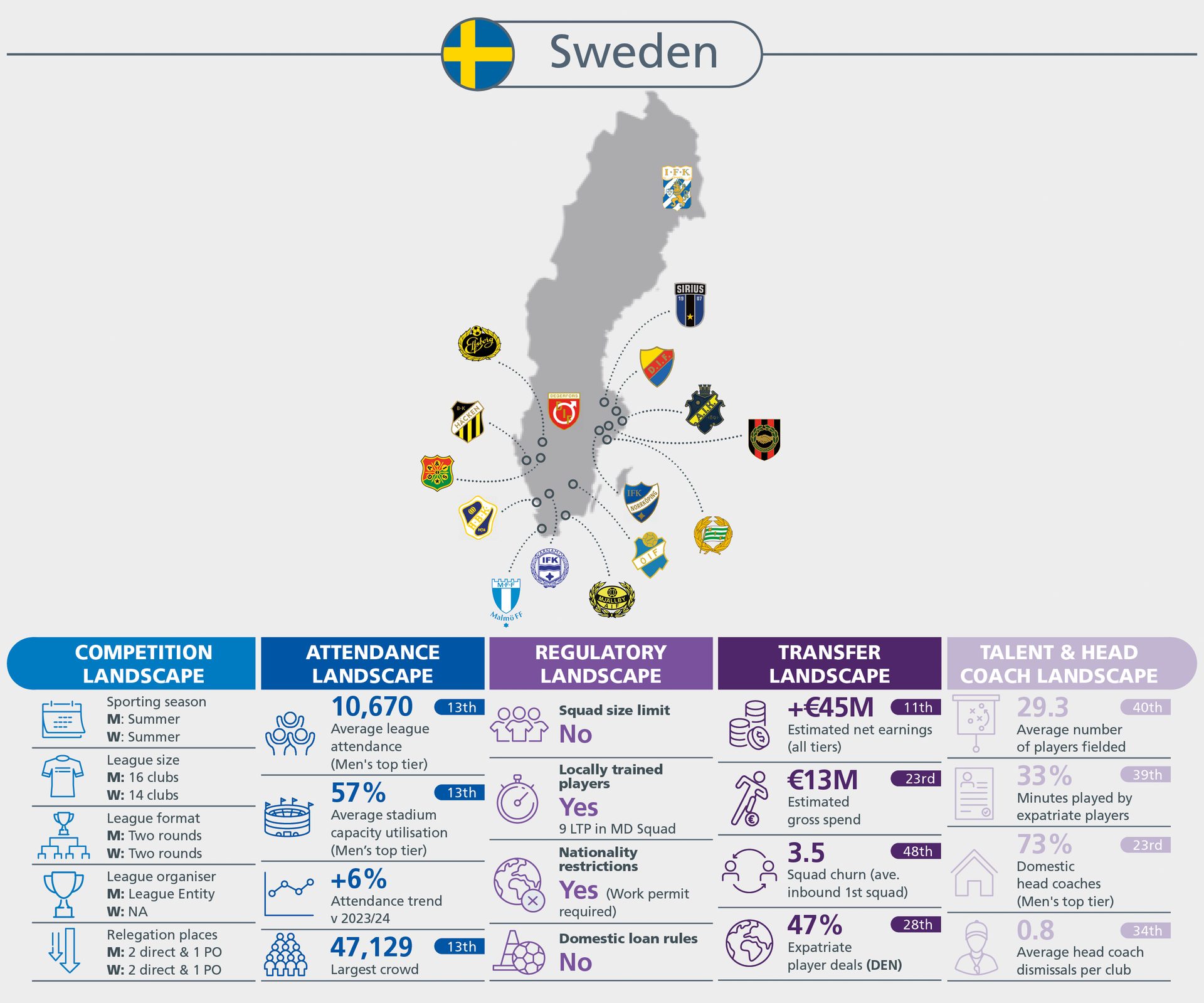

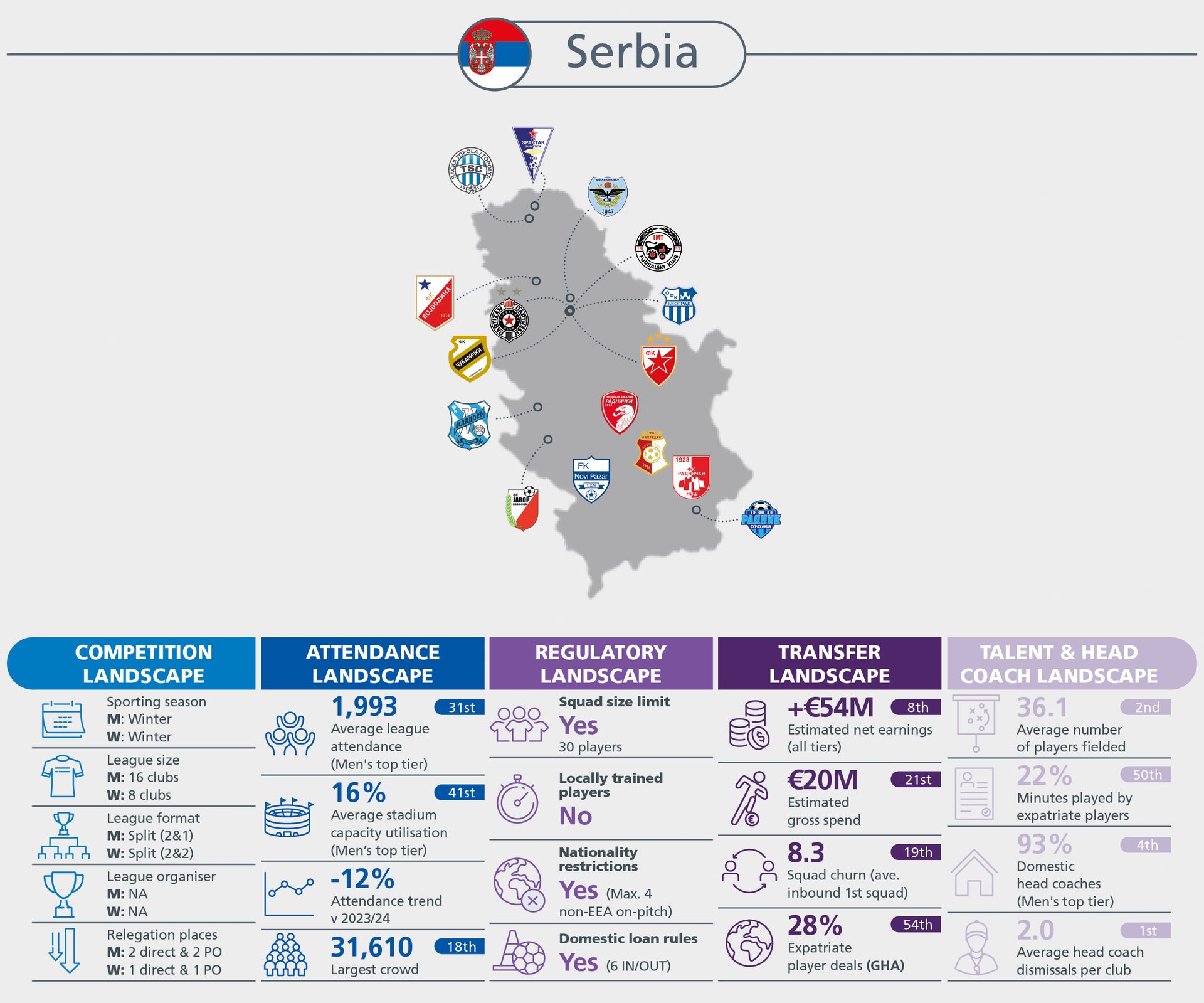
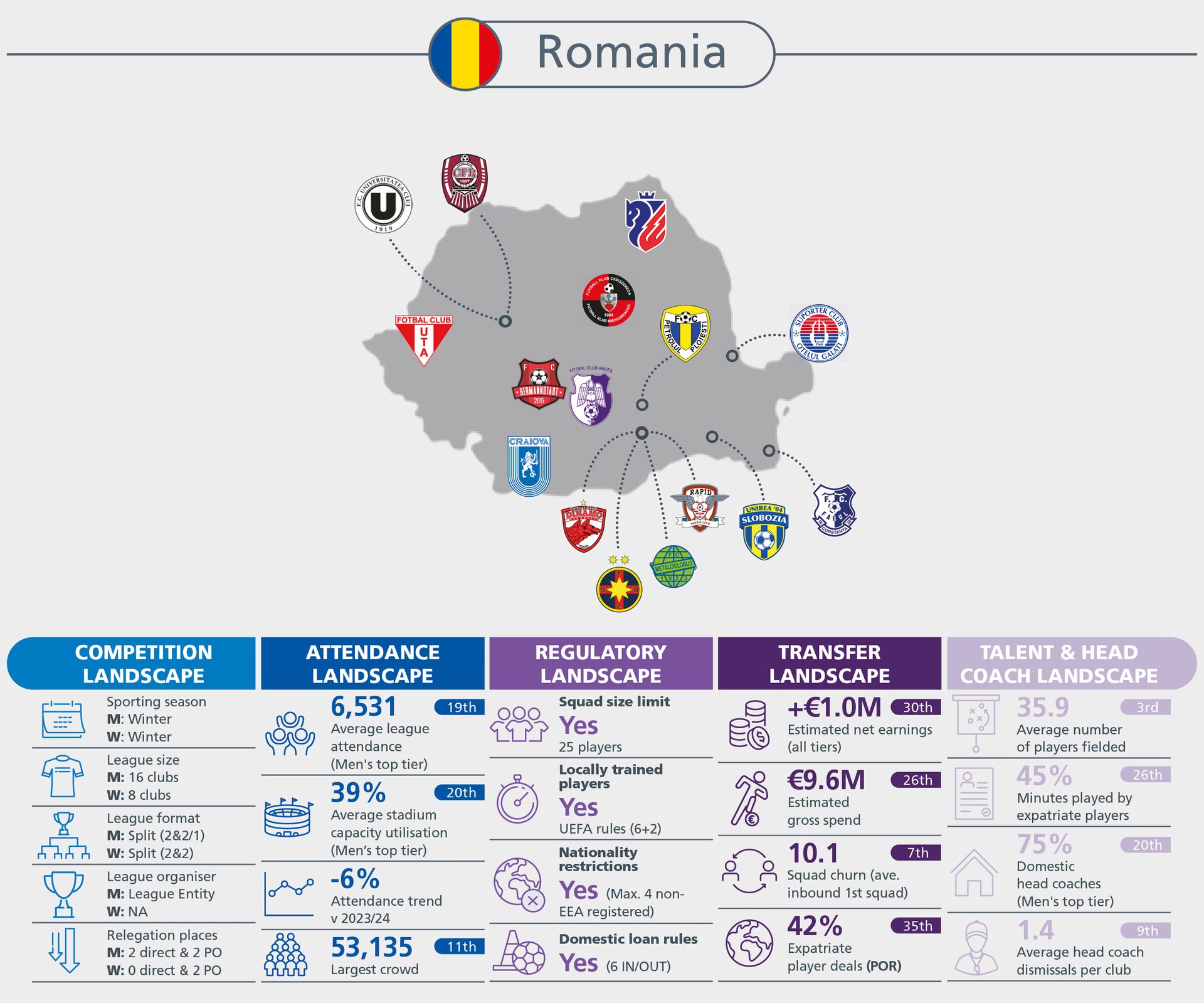
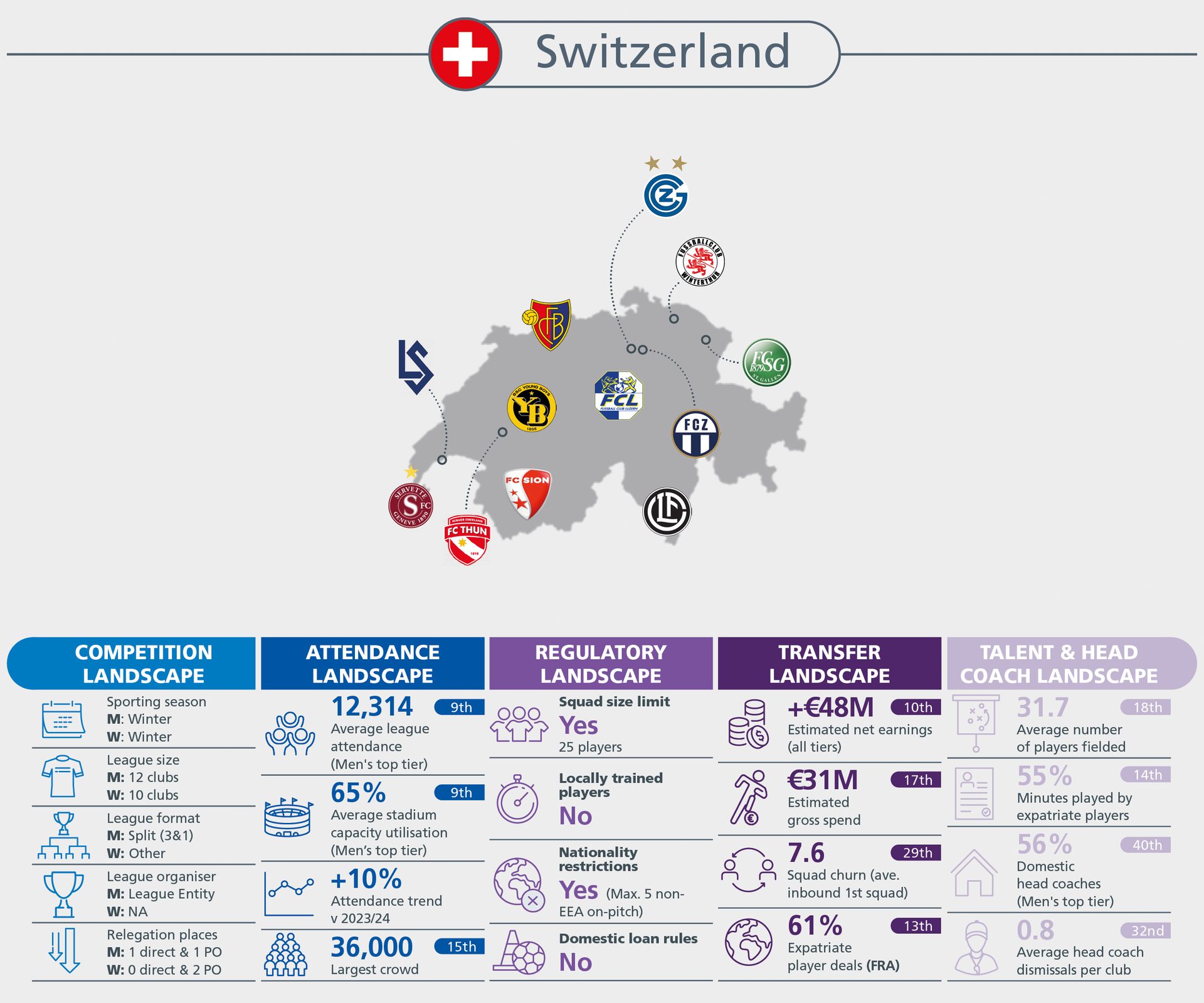
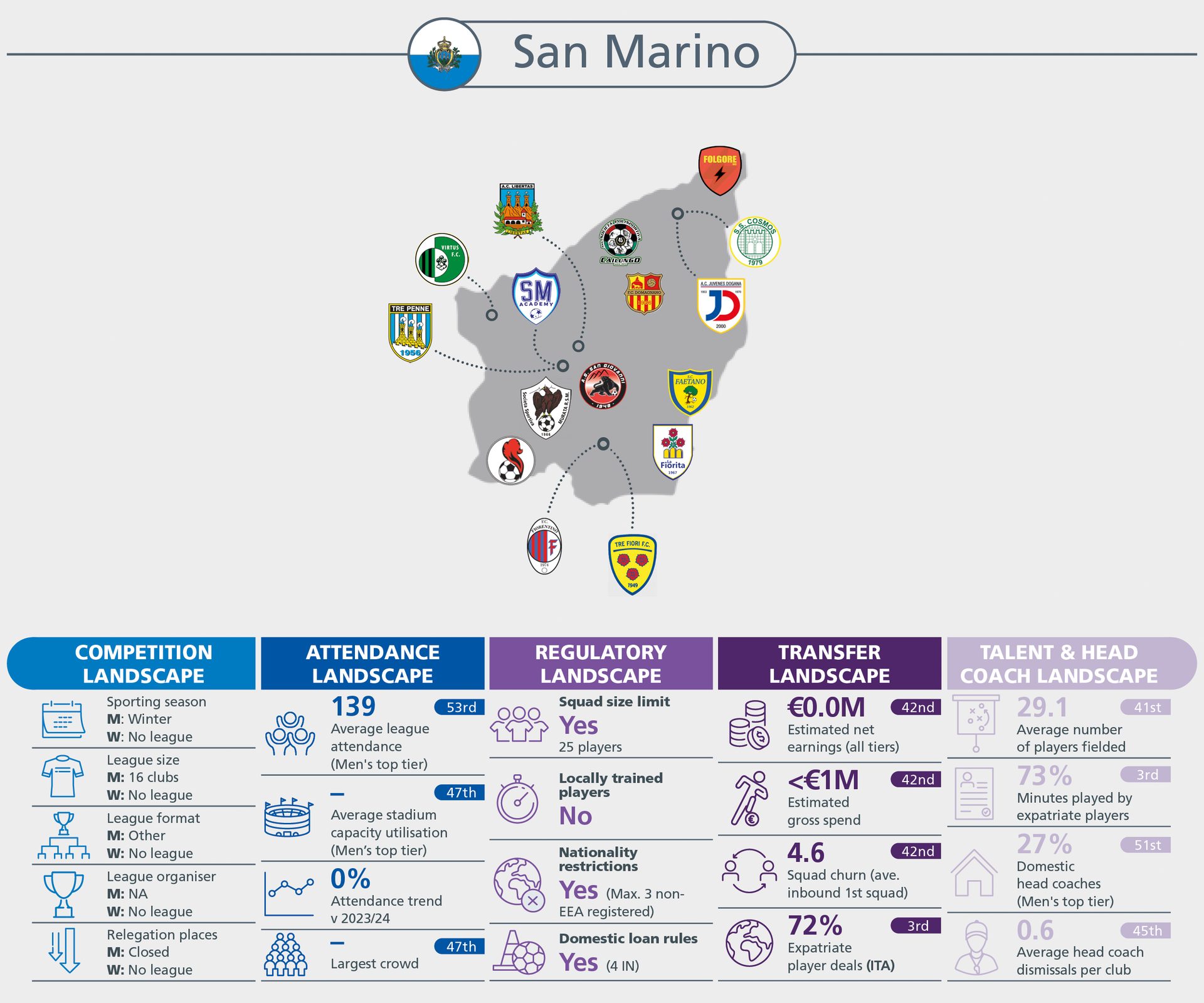
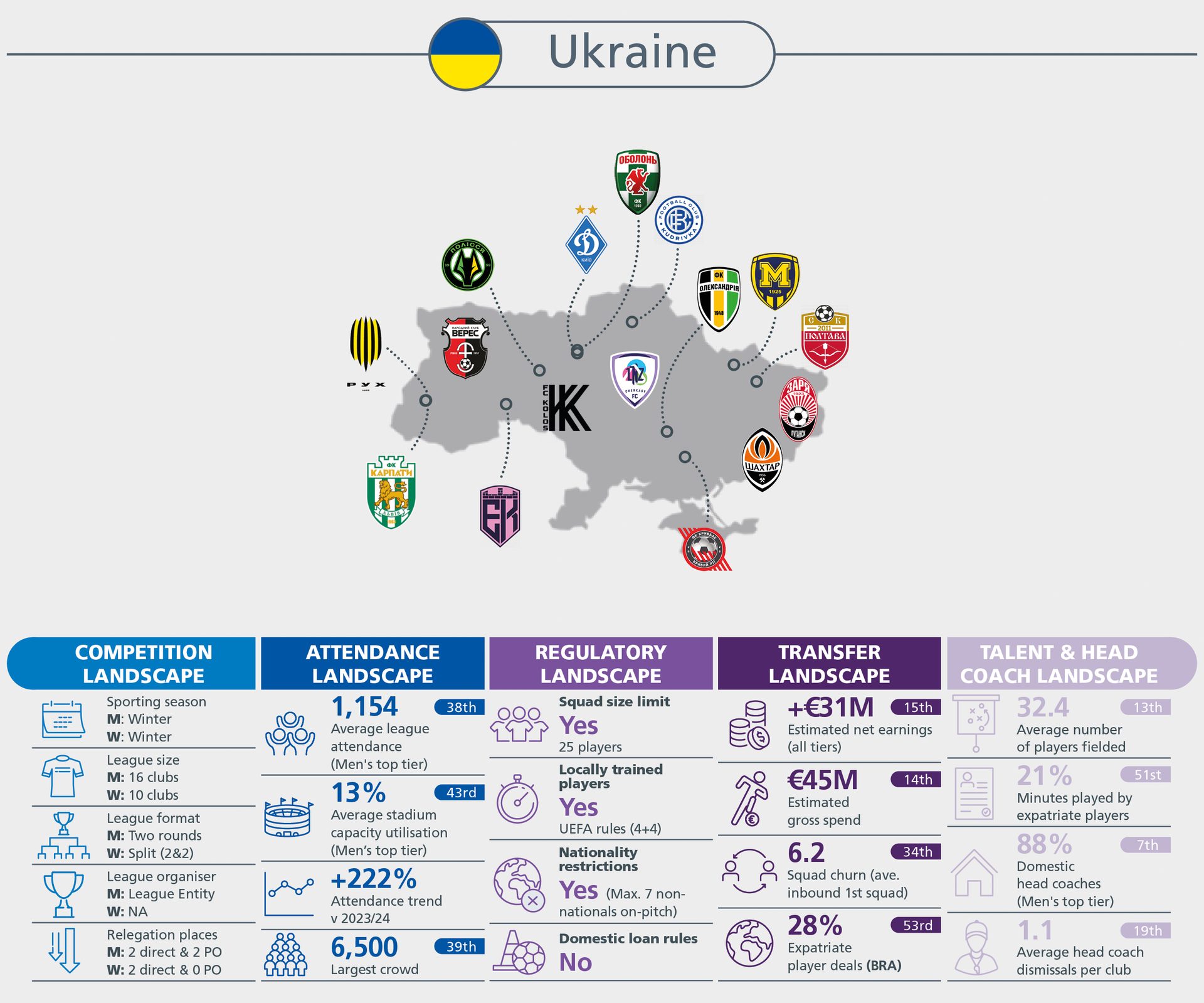
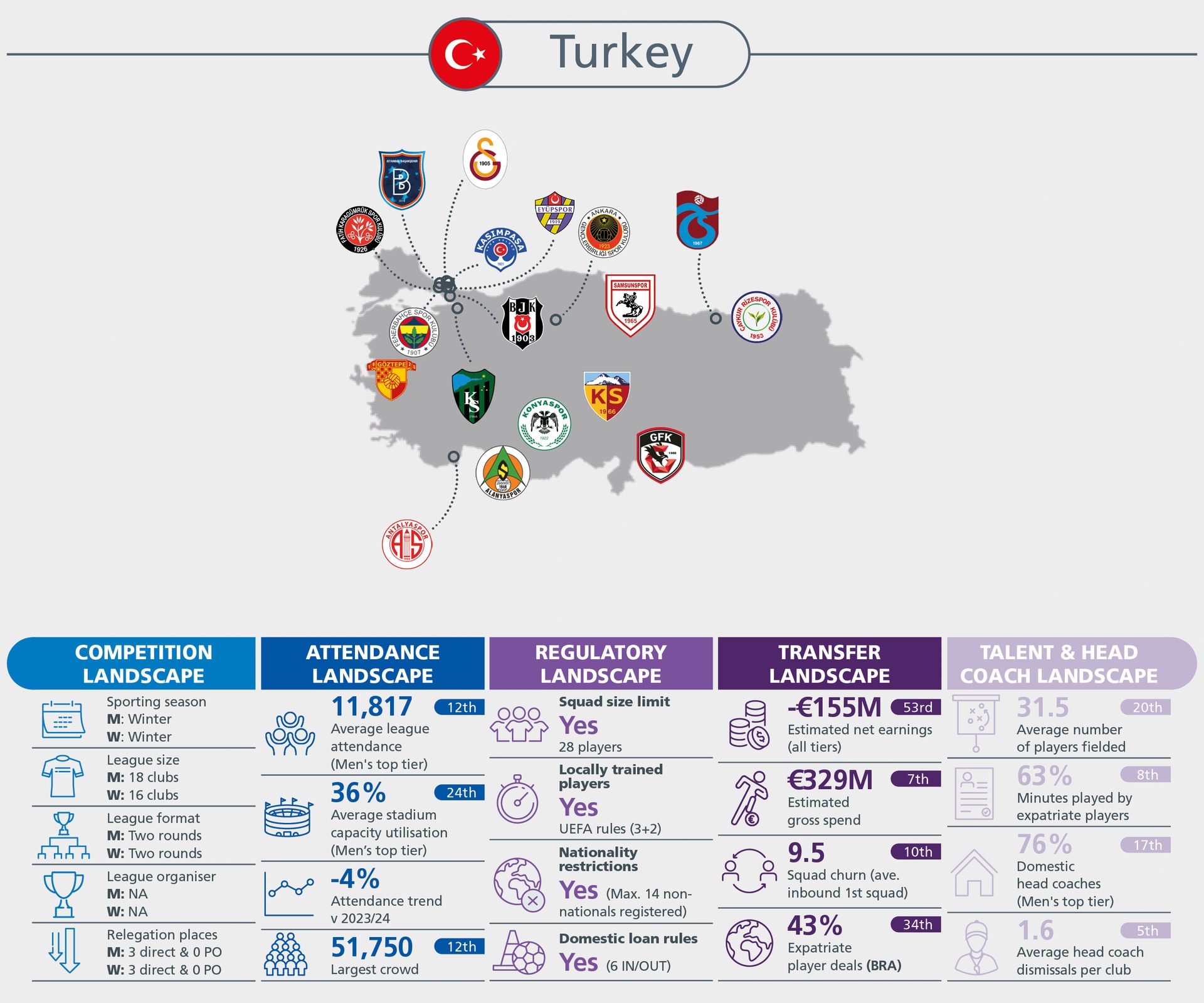


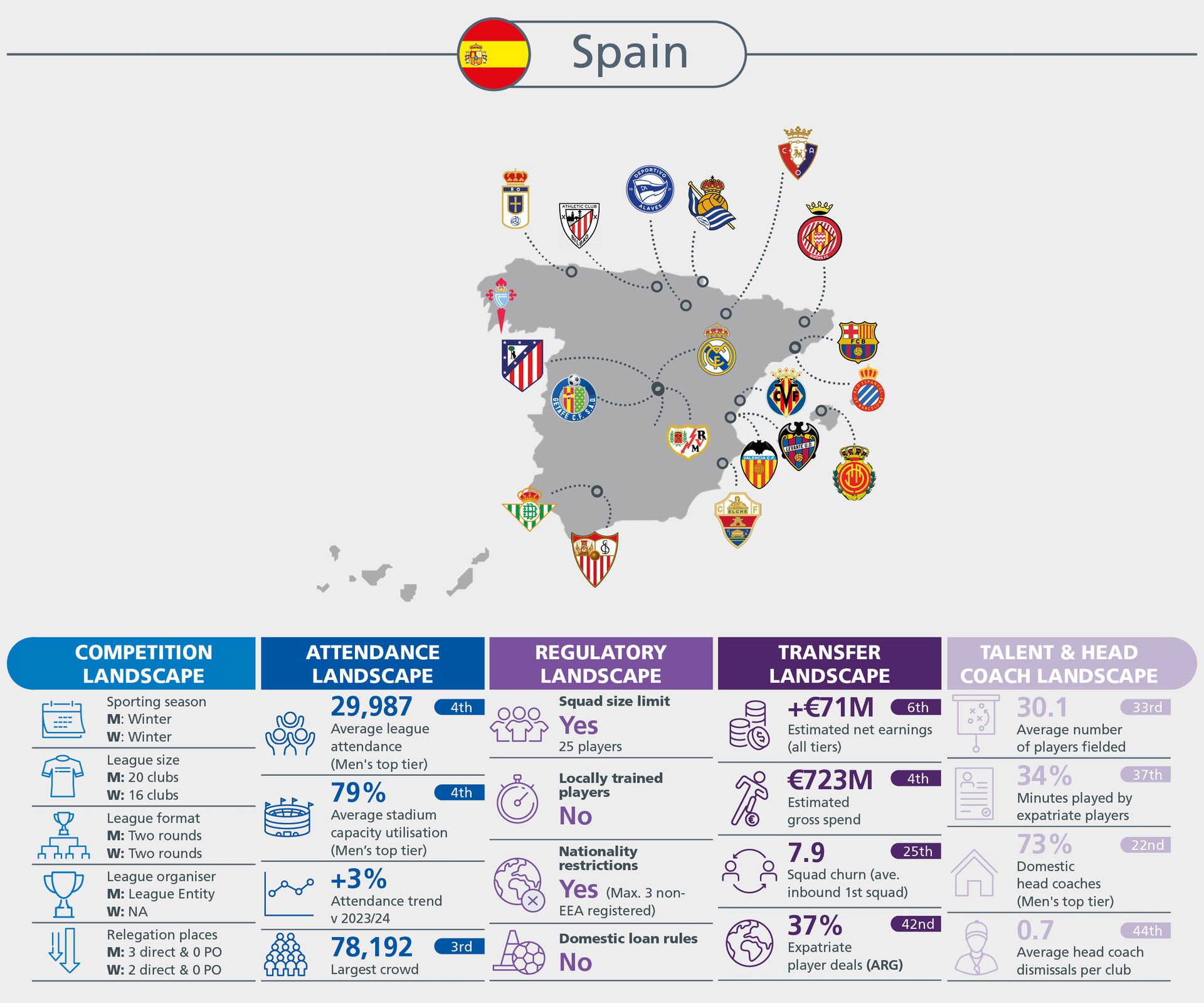
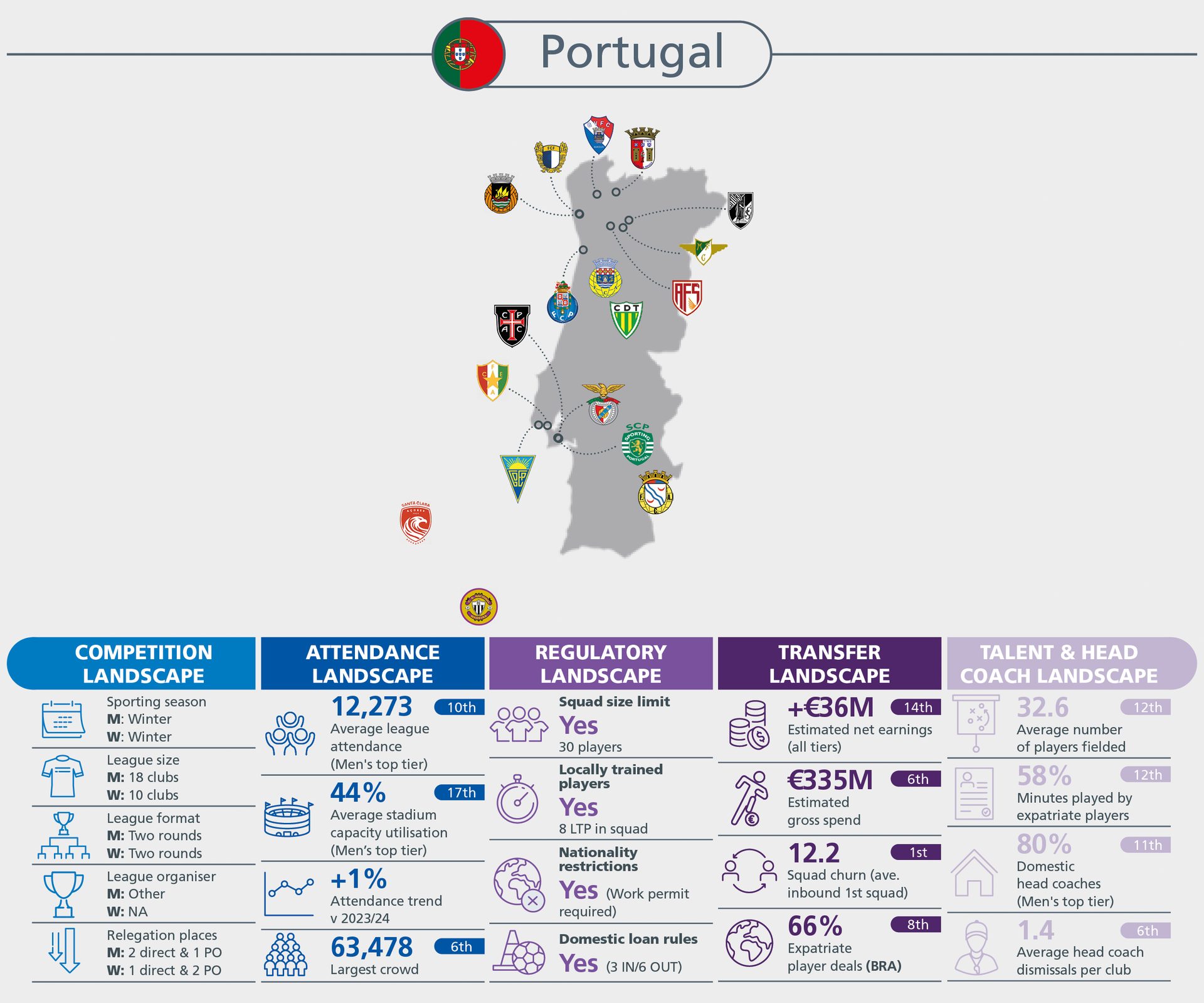
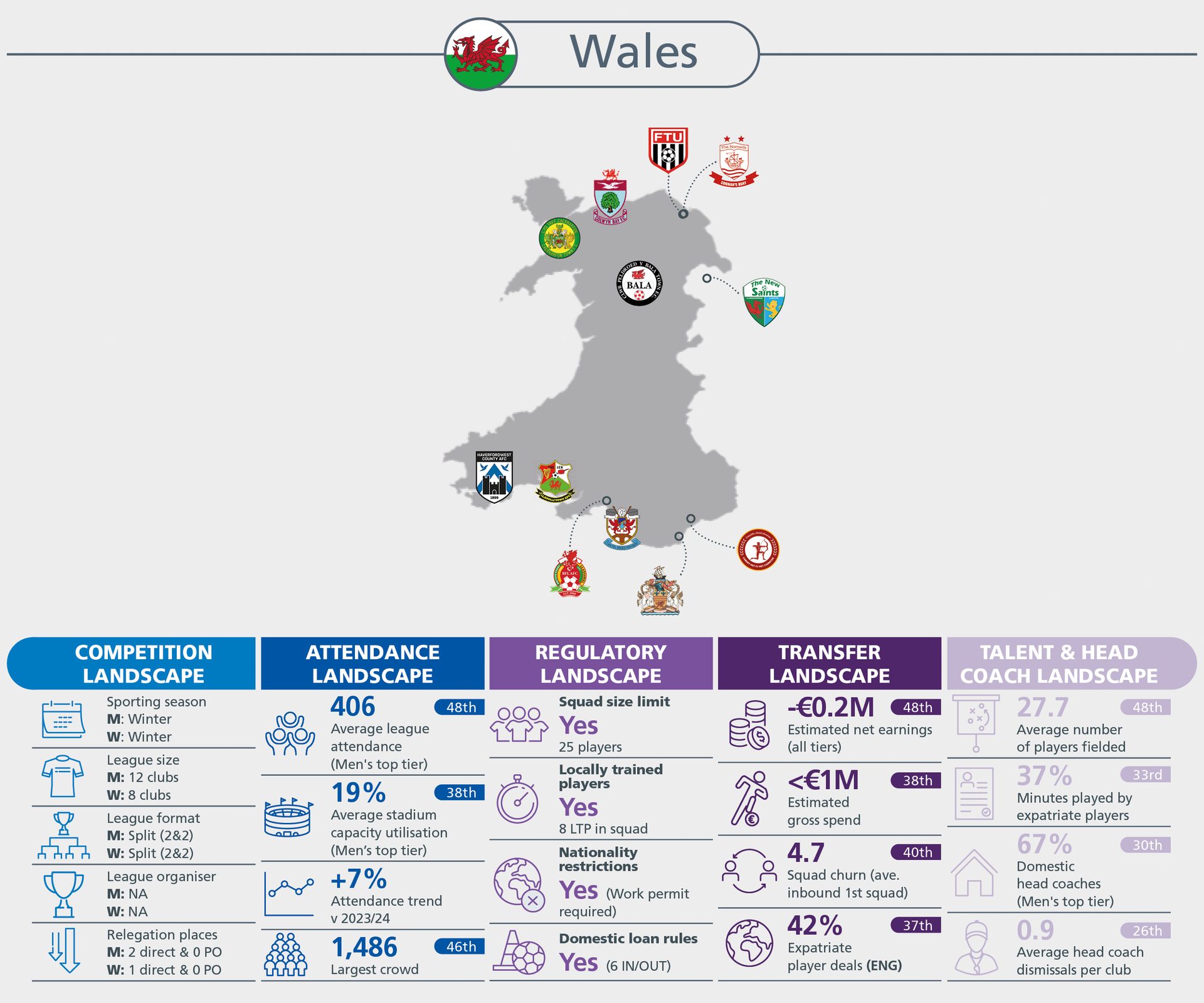
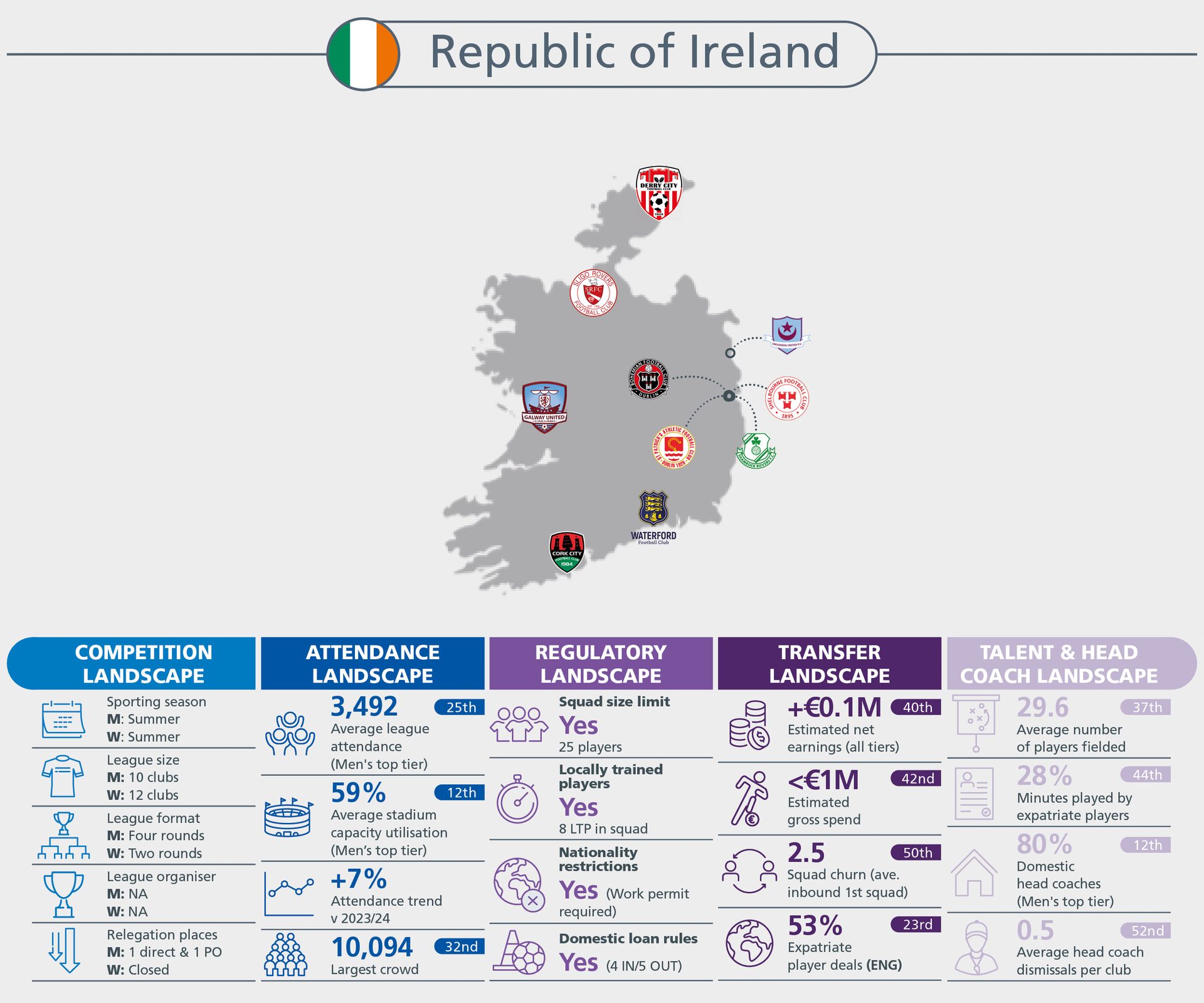
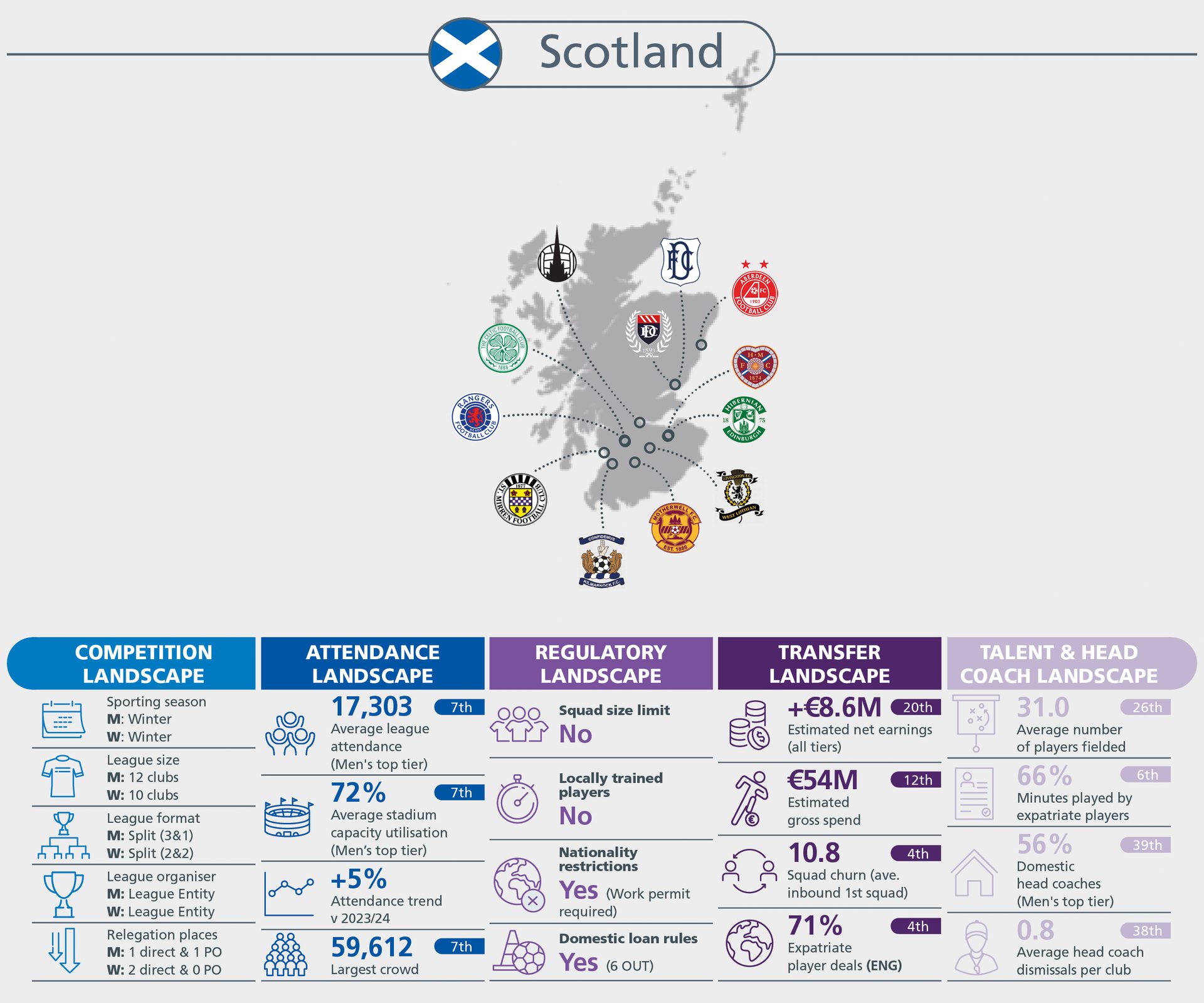
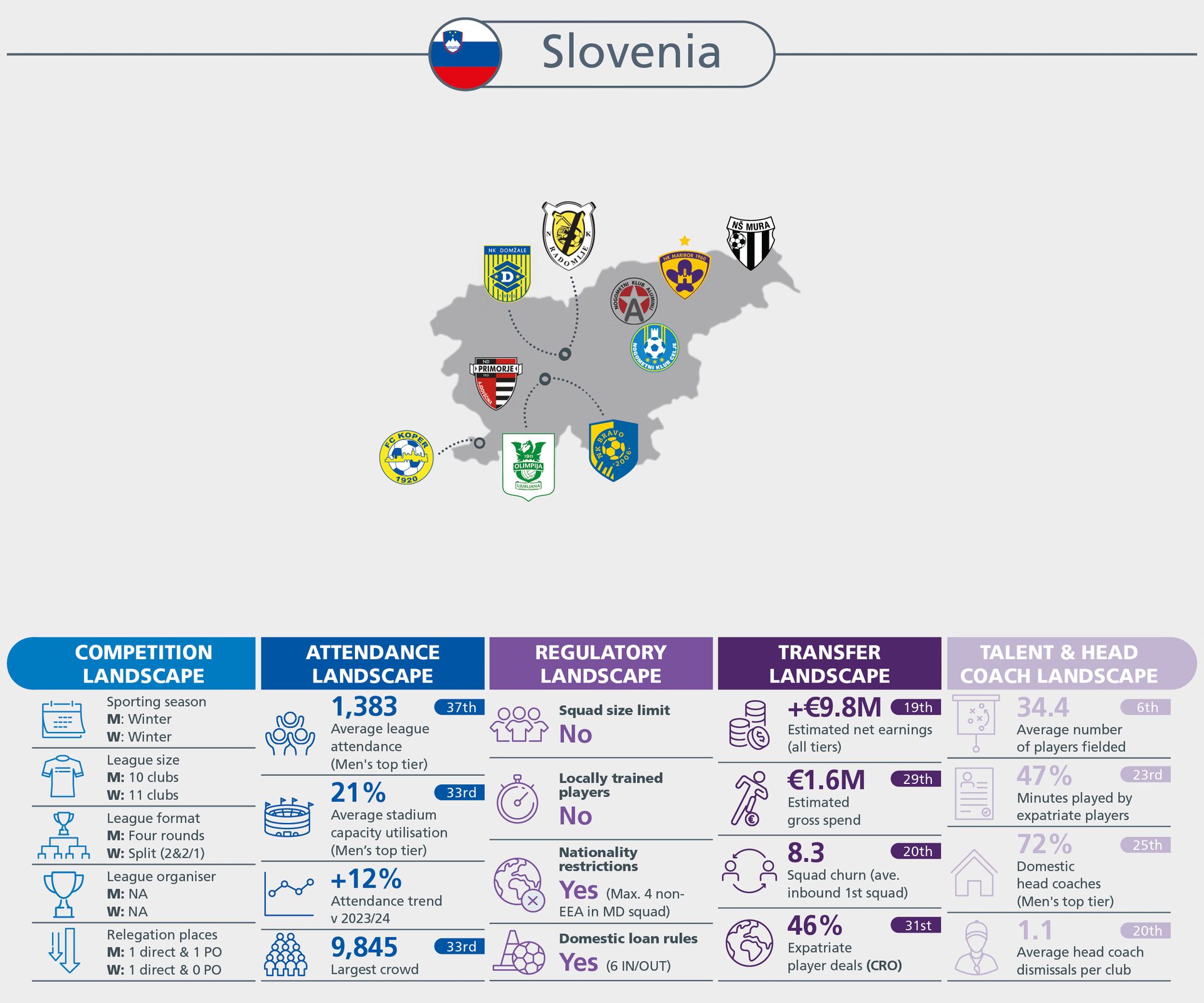
Click on each country to view benchmark statistics.

10%
of head coaches were at a club from their own country
Benchmark
statistics
Click on each country to view benchmark statistics
